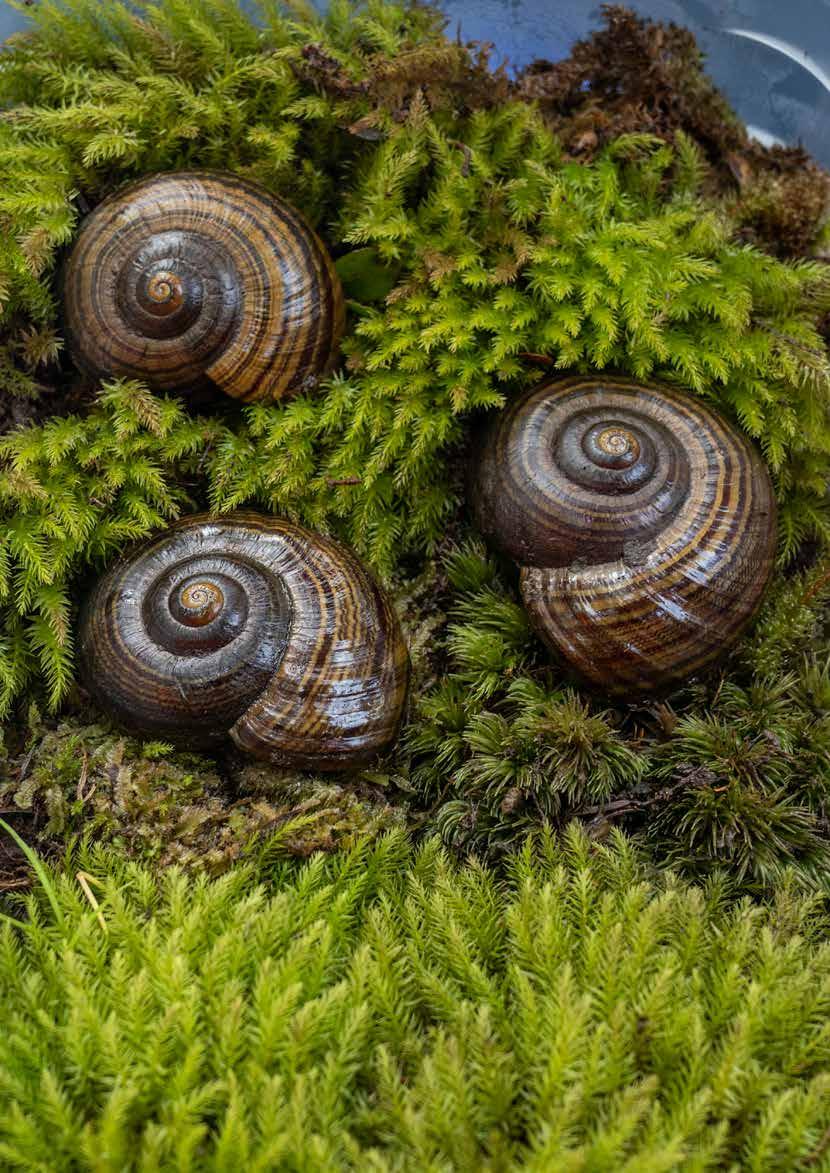
ANNUAL REPORT 2021/22
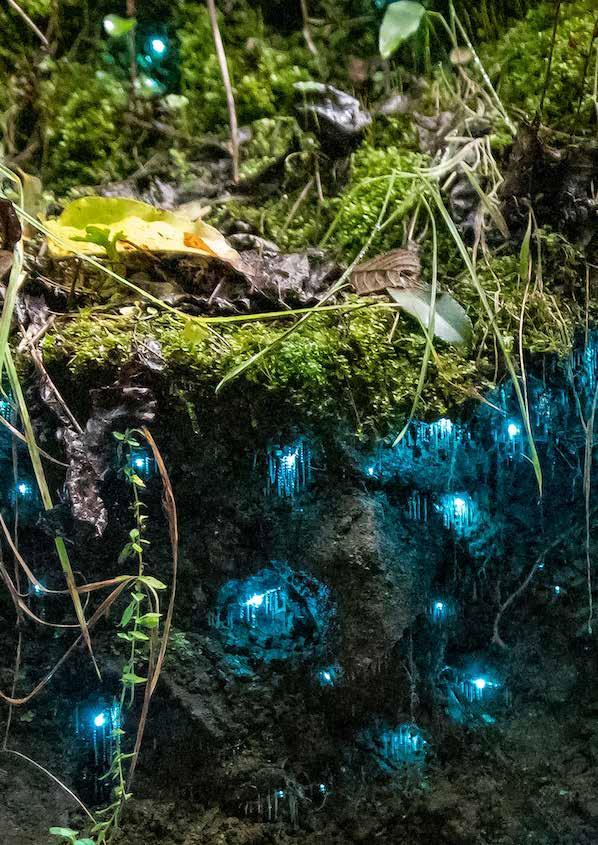
2
Photo: Andrew MacDonald
Ngaro reoreo tangata, kīkī e manu No human voices, only the twittering of birds
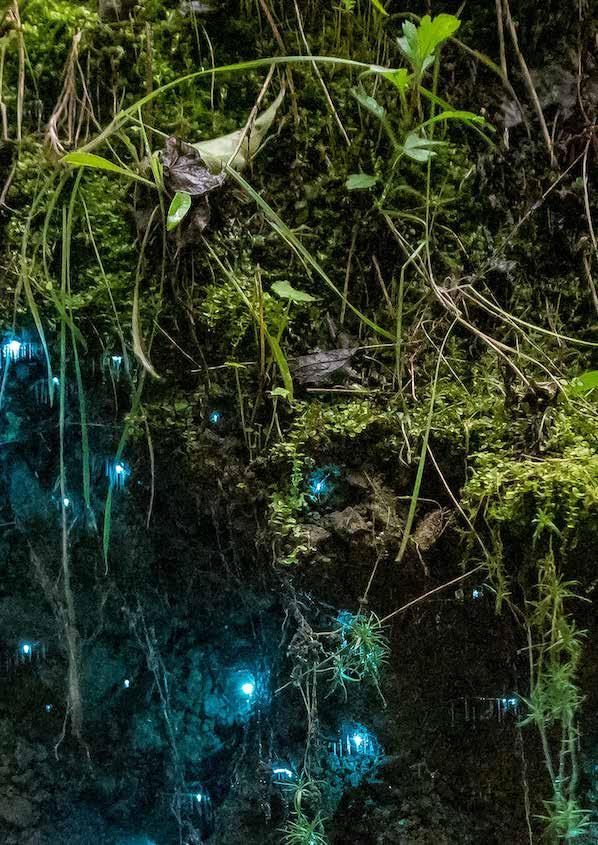
Contents 3 4 Chairman’s report 8 Treasurer’s report 9 Chief Executive’s notes 9 Achievements for 2021-22 11 Social capital 14 Our support partners, sponsors, and donors 15 Environmental capital 17 Human capital 18 Experiencing nature; our visitors 19 Future action 20 Our Trustees 21 Health, safety and wellbeing 22 - 42 Performance report 2021/22 43 Independent auditor’s report
As Trust Chair I am delighted to report that over the past twelve months the Sanctuary has continued its forward momentum, building on previous year’s notable achievements.
Four key events stand out, over the past 12 months, these are:
• Very successful introduction of the rare and endangered kākāriki karaka – the orange-fronted parakeet

• The translocation of ~30 powelliphanta (endemic carnivorous land snails) sourced from local sites in the Roding Water Reserve, and from Ngati Koata land in the Maitai Valley
• The appointment of a new Trust patron – Lou Stanton, former Director General of the Department of Conservation

• Substantial additional financial support and recognition from a strategic and key sponsor who notes ‘the sanctuary is heading in the right direction and am pleased with what has been achieved to date’ (paraphrased).
These four “events” have contributed to, and enhanced, the profile of the Brook Waimārama Sanctuary and have raised awareness of the Sanctuary within our region.
Other significant activity in the Sanctuary in the past year includes the establishment of new walking tracks, the placement of the new bridge at the Flagstone Crossing, and commencement of the upgrade and refurbishment of the Sanctuary’s Visitor Centre. These are just some, but certainly
not all, the key activities undertaken during the financial year.
We continue to improve in our external communications both in content and channels utilised reaching not just the local populace but potential visitors to the region from elsewhere in New Zealand. The Board, along with senior management are aware we need to tell our story, to explain what we are doing, what we are planning, initiatives underway along with the
4
Chris Hawkes, Chair, Trustee
CHAIRMAN’S REPORT - CHRIS HAWKES
Kia ora Koutou Katoa
resulting highs and lows of operating a Sanctuary – and there are many! All resulting in increasing visitors through the gate which will help us to meet our stated commitments, and at the same time provide a unique and memorable experience to all.
The growth in Sanctuary supporter numbers (aka membership) over the past year from 875 to 1400 is an indicator of our continued development. Other indicators, such as visitor numbers reaching the same level as the previous year should be recognised as a significant achievement in a very difficult period due to COVID19.
The Sanctuary Board and Chief Executive are of the view that the Brook Waimārama Sanctuary can become a key regional visitor destination for both domestic and international visitors, and that this presents a commercial opportunity for the city to grow by helping the Sanctuary to the recognised for the amazing community asset that it is.
I am also of the opinion that the contribution made by 400+ volunteers - their enthusiasm, knowledge, hard work, and the time committed to the continual protection and improvement of the Sanctuary environment is not fully appreciated or understood by the wider Nelson community. For, as is often said, without our team of volunteers there would be no Sanctuary, certainly not in the condition or at the levels of service that it is today, and Nelson’s biodiversity would be poorer for it.
In the past year, the Sanctuary has experienced several pest incursions ‘behind the fence’ but thankfully, not to the same scale as last year. Although we make diligent efforts to mitigate the risks of pest incursions, the unfortunate reality that we’ve accepted is that from time-to-time incursion events will occur. The speed with which our staff and volunteers deal with these pest incursions and fence breaches is truly remarkable and gives confidence to all parties that we are on top of our game and can move rapidly once an incursion is detected or suspected.

Financial
The 2021-22 financial report shows that despite the negative influences of COVID19 and challenges faced in the past year, the Sanctuary has maintained a ‘steady’ financial position ending the year with a modest operational surplus. This is due to the continuing support from our sponsors and funders, who have contributed cash and ‘in kind’ support. The Trust has diligently managed our expenditure; it should be recognised that the high level of volunteer labour input, particularly into maintenance and
capital developments projects, contributes enormously to the bottom line result.
Ensuing Year
The groundwork has been laid for further species translocations/introductions with the signing of a Memorandum of Understanding with Ngati Koata iwi for the introduction of tuatara to the Sanctuary. The actual introduction of tuatara will not happen until we have completed the necessary containment area and received sign off by the Department of Conservation. Initial talks
Photo: Andrew MacDonald
BROOK WAIMĀRAMA SANCTUARY TRUST ANNUAL REPORT 2021/22 5
for the translocation/introduction of other species have also been initiated, however, it is too early yet to comment further on what these might be and when they might happen.
As mentioned earlier, the refurbishment of the Sanctuary Visitor Centre was started at the end of the 2021/22 financial year and excellent progress has been made to date. This project is certain to be a highlight for the new financial year starting 1 July 2022.
Our Chief Executive has recently completed visits to a number of larger, and several smaller sanctuaries throughout New Zealand, and has met with key iwi, primarily in the South Island, who are active in the species translocation/conservation efforts. In doing so, Ru has established a cordial, supportive working relationships with key players and other Sanctuaries. An opportunity exists for all Sanctuaries to speak / coordinate as a collective or sector, especially in their dealings with Government and other associated parties.
In the coming year, we’ll continue to work on challenging issues such as, the entrance to the Sanctuary is through the Brook Motor Camp, our need for increased parking and turning space for buses, and the continued development of our walking track network. The aesthetics of the Visitor Centre entrance are important project we’re working on.
The Board have approved a new sales position within our staff; this part time role is intended to promote the Sanctuary to increase visitor numbers, encourage more sponsorship, engage with specific groups such as retirement villages and special interest groups, regional tourism accommodation providers to ensure the Sanctuary and its key events are well publicised. This role will cover all New Zealand but will be primarily targeted at the traditional South Island summer visitor(s) and locals in initial years.
Education of our younger folk is, as it always has been, a key purpose of the Sanctuary and the past year has witnessed this developing to a higher level with an increase in school groups visiting the Sanctuary. The Trust has increased its staffing and resourcing for this important aspect of the Sanctuary’s activities. In the 2022 school year, student visits to the Sanctuary are already up 32% on the whole of last year with the final term, usually our busiest still, to come.
This year I am not going to thank you all as per tradition in a Chair’s report, instead, I am going to do is ask you to turn and look to your Sanctuary friends, co-workers, whether staff, volunteers, supporters, or sponsors and say, “Great job, well done” and shake hands. You can be rightly proud of all your achievements – I certainly am!
Chris Hawkes Chair
A group of 30 snails from the Maitai and Roding sites, were released into the Sanctuary on 17 June. The specific release sites were pre-selected and pegged by Kath Walker, who was, unfortunately, unable to attend on the day. The release was attended by Sanctuary staff and volunteers, iwi representatives, Nelson Nature staff and senior high school students. The pegs were removed after the release in order to avoid creating too much curiosity amongst Sanctuary volunteers

6
Translocation of Powelliphanta hochstetteri consobrina to Waimarama/Brook Sanctuary
KĀKĀRIKI KARAKA
Three species of kākāriki were once widespread throughout mainland New Zealand: yellow-crowned parakeet (Cyanoramphus novaezelandiae), red-crowned parakeet (Cyanoramphus auriceps), and orange-fronted parakeet (Cyanoramphus malherbi). The three species have similar habits, diet, and breeding biology, but occupy different niches in the forest.
The kākāriki karaka is considered to be a midcanopy understorey forage species, and the wild mainland population is now confined to less than 100 birds in just three alpine beech forest valleys in the Arthur’s Pass region.
The wild kākāriki karaka population has numbered about 360 birds, limited to several Canterbury alpine valleys and predator-free Blumine Island in the Marlborough Sounds. Since 2005, over 300 captive bred parakeets have been translocated to Chalky Island in Fiordland, to Maud and Blumine Islands in Marlborough Sounds, and to Mayor Island in Bay of Plenty.
Kākāriki karaka are highly vulnerable to predators like rats and stoats and their populations can be quickly devastated during years when the beech trees mast, or seed heavily, and predator numbers increase dramatically.
The kākāriki karaka is therefore the rarest of the three species of mainland parakeet and classified as “nationally critical” putting them in the same category as kākāpo, takahē, black stilts, and black robins.

The Department of Conservation’s orange fronted parakeet recovery team first approached the Brook Waimārama Sanctuary in early 2019 concerning a possible translocation of kākāriki. Due to its large size, predator proof fence, intensive monitoring, and largely pristine habitat (including sizeable beech forest), the Sanctuary has been identified by DOC and iwi as a desirable place to translocate kākāriki karaka.
A total 104 kākāriki karaka were translocated to the Sanctuary in five translocations between November 2021 and May 2022. These birds were reared in captivity at the Isaac Conservation and Wildlife Trust and Orana Park in Christchurch.
Since their translocation, unbanded fledglings have been sighted, confirming that the birds have been breeding within the Sanctuary since their arrival.
7
TREASURER’S REPORT - MAURICE WOODHOUSE

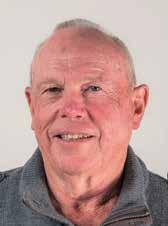

The year ended 30 June 2022, resulted in a surplus of $24,472 after allowing for depreciation of $180,566. The cash surplus for the year being a healthy $203,080. This was largely due to an increase in donations and bequests of $308,103. The Trust also experienced an increase in membership revenue as a result of its increasing base. On the expenditure side salaries increased by $199,198 to $611,505, much of this being additional staff positions that were funded by grant income. Maintenance and professional fees also increased as a result of remediation work and upgrades undertaken. In an effort to future-proof the Trust, it has begun to invest with the newly formed BWS Foundation, the aim being to build a fund which will generate future income to support the Trust’s ongoing activities. It is extremely satisfying to report that having made an initial investment in the Foundation of in-excess of $220,000 and that the Foundation’s working capital is still $32,130, compared to $193,665 the previous year.
In conclusion, the Trust through the ongoing dedication of its staff and Chief Executive, volunteers and trustees has continued to prosper and develop over the past year. It is indeed exciting to see the physical improvements and the steady reintroduction of species by the Trust. Once again, a special thankyou to all those who freely give so much of their time to this amazing project.
Maurice Woodhouse Treasurer
8
Maurice Woodhouse, Trustee, Treasurer
CHIEF EXECUTIVE’S NOTES - RU COLLIN
This report highlights key achievements for the year and reports against the four capitals of social, environmental, cultural, and financial. The highlights of the year must include successful translocations, improved culture of teamwork across staff and volunteers, visitor feedback and an improved financial position. We also managed the operation through the COVID19 pandemic responses with minimal disruption.
During the year ending 30 June 2022, the Sanctuary has worked through a long list of activity and achievements, too numerous to all be noted in this report. Highlights that stand out for me include:
• Posting an end of year surplus of $24,472 after depreciation
• The appointment in March 2022 of Lou Sanson (former Director General of Department of Conservation) as the new Sanctuary Patron

• The completion of our second and third species translocations with the arrival of kākāriki karaka in late 2021 and into 2022, and powelliphanta in the Sanctuary from June 2022
• Seeding investment in the Brook Waimārama Sanctuary Foundation
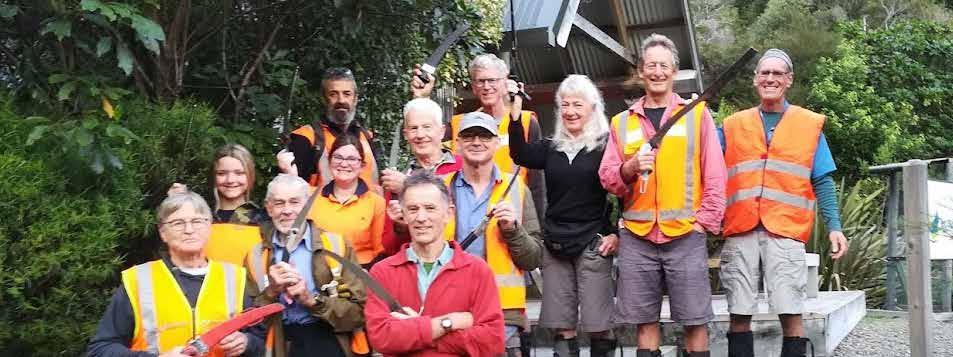
• The establishment of our noxious weeding eradication team (a three-year project)
• Gaining approval from the Department of Conservation to translocate kākā to the Sanctuary and the construction of a large temporary holding aviary for the eventual arrival of kākā
• Completion of the handrails project on The Loop and the installation of the Flagstone Bridge
• Moving the town office to much larger, and multi-function office space in Morrison Square
• The significant refurbishment of the Visitor Centre got under way in June 2022
BROOK WAIMĀRAMA SANCTUARY TRUST ANNUAL REPORT 2021/22 9
Ru Collin, Chief Executive
Along with the notable achievements mentioned above, the Sanctuary team of Trustees, paid staff and our volunteers have diligently monitored for mammalian pests and responded to pest incursions, fence breaches, repaired and/or constructed new Sanctuary assets such as the fence, our walking track network etc. We’ve made numerous improvements to our systems and processes and have continued to better resource our teams with the tools and skills they need to do their allotted tasks.
Another pleasing result is the growth of our volunteer base to exceed 400 and with our paid supporter base 1380.
We have partnered with numerous sponsors and supporters on a variety of projects, such as MACPAC and NBS – both organisations provided our people with outdoor clothing. There are simply too many partners to mention by name in this report in detail – but our heartfelt thanks to all of these Sanctuary supporters.
My position as Chief Executive is well supported by the small team of permanent staff - Nick Tilly, Nick Robson, Robert Schadewinkel and Murray Neill. Deborah McConochie and Rick Field are contractors who have ably assisted in the fundraising and education delivery. From October 2021 we also established a dedicated weeding team of paid employees (Chelsea Haley, Iesha Hogarty and Chris Sheehan supported by (COVID response) Jobs for Nature funding with up to three additional staff. Thanks to government funding for the Project Mahitahi: Kaimahi for Nature project coordinated by DOC, iwi and NCC we were also able to fill part time roles dedicated to events, marketing and promotions (Liv Gallagher), education delivery (Shani Bennett), biosecurity (Steffi Kuenstle) and the Visitor Centre and Volunteer Coordination (Kirsten RoedsgaardMathiesen and Mary-Anne Cameron).

10
SOCIAL
This is the value generated from social networks or groups of people who work for the common good for the community of Nelson and Tasman region.
The Sanctuary is part of an active network supported by Nelson City Council (NCC) called Nelson Nature. The two projects of most relevance to the BWST are the Wildlife Halo/ Nelson Halo and Biodiversity Corridors.
From July 2021 we also decided to give something back to the community by providing free Sanctuary admission passes to three entities: the Red Cross, Big Brothers, Big Sisters and to Nelson’s land search and rescue (SAR). The passes were gladly accepted and have been used.
Volunteer effort
Important in the success of this organisation is the input of our volunteers, both from operational and governance perspectives. The total hours estimated and recorded against the Sanctuary represents a high level of commitment from many hundreds of people.
involvement 2021/2022
Notes to table
• Administration hours are reducing each year as more work is undertaken by staff, and less additional work required by trustees
• The volunteer efforts with track maintenance, fence inspection and repair, and with pest monitoring and detection were huge
• General line represents hours recorded, but not coded, with most to pest detection or survey work
Pest Detection Team
The pest detection team of approximately 180 volunteers is critical to our ability to prove that the Sanctuary is pest free and ready and waiting to safely accept new species and reintroductions. These volunteers have had a very busy year with more than usual monitoring activities required.
In the last year we had about:
• 11 Fence Breaches (Swales and Fence)
10 Biosecurity breaches. Estimated the time spent
• Fence Breaches: 730 hours
• Biosecurity Breaches: 770 hours
The team put in approx. 7,000 hours in the Sanctuary, which encompasses the following activities:
1. Regular weekly and monthly monitoring and rebaiting of the perimeter and interior
2. Quarterly Sanctuary wide surveys (SWS)
3. As required “Response” monitoring and baiting to manage any fence breaches and or incursions immediately they happen
4. Monthly Mouse Surveys
BROOK WAIMĀRAMA SANCTUARY TRUST ANNUAL REPORT 2021/22 11
CAPITAL 1 July - 30 June 2022 2022 2021 Administration 3,700 4,420 Assets 1,138 2,045 Bird Monitoring 2,408 1,011 Fence Inspection 45 865 Fence Maintenance 1,349 1,564 Pest Detection 4,643 6,905 Cards 2,792 630 Track maintenance 1,969 4,624 Visitor Centre 1,605 1,930 Weeding 719 774 Planting 161 161 General uncoded 565 TOTAL HOURS 21,093 23,711 Volunteer
•
Further explanation
• Point 1 is about business as usual for the sanctuary volunteers in managing our perimeter (our first line of defence) and rebaiting approx. 250 DOC200 traps in the interior (currently our only weasel defence).
• Point 2 is a huge initiative, usually every quarter to bait and card almost 2.5k monitoring tunnels and a week later to collect the cards and examine for any pest footprints. Sadly, because of incursions, we have already had three SWS from January to June. This process takes significant organisation and collaboration by the SWS co-ordinator, the line co-ordinators and our Sanctuary staff and usually involves about 80 of our volunteers for two weekends. However, recently to close the door on a rat incursion in February the team put in a huge effort over 3 wet weekends in June, putting out and collecting cards twice. The weather over these 3 weekends was very wet but the team stoically went out and completed the job. A fantastic effort.
• Point 3 explains the aspect of rapid response, where a more spontaneous and ad hoc volunteer effort that by necessity involves very fit and flexible volunteers who can drop everything and act immediately - this typically happens mid-week. Every time there is a pest detected and/or a breach of the fence through treefall or storm damage, the “response” team swings into action immediately to set up a standard monitoring grid (15 traps/tunnels) which is then inspected twice weekly in the first 2 weeks and then weekly for another 6 weeks –8 weeks in total.
• Point 4 is a process we have employed in the Sanctuary interior since 2020, whereby we gather valuable monthly mouse population data from a consistent sample area of lines and 100 monitoring tunnels within the perimeter. The survey uses the established DOC methodology for monitoring changes in the abundance of rodents and/or mustelids. (This allows data to be compared with previous data and with other parts of the country if necessary.)
Increased abundance of these rodents will typically trigger an assessment regarding an intervention to reduce numbers.
So, all in all our Pest Detection Volunteers have had a huge year, firstly by maintaining the regular and routine perimeter and DOC200 monitoring, but also, as a result of breaches, and individual rat and weasel incursions. We are hopeful that the next year will not be quite so busy, but the team are up for the challenge and continue to deliver peace of mind by confirming our Pest Free status for all our key stakeholders.
The 2021/22 focus was primarily making the Sanctuary environment ready for species reintroductions and with pest detection.

12
Our volunteer representatives
We would like to also acknowledge the volunteers’ efforts -especially the team leaders at the Sanctuary Pete Jamieson, and Kath Ballentine and Sabrina Malcolm, our volunteer connector. A special thanks to the ten volunteer team leaders who have continuously worked on Sanctuary projects and issues throughout the year.

Dave Garnett and Annette Cunningham represent volunteers’ views as volunteer reps and speak directly to the board offering great advice and their perspectives are valued. Their efforts as the official volunteer links between volunteer pool, and myself and staff over this period have been invaluable and have helped bring all parties closer together to work more effectively as a team. These roles aim to improve the exchange of ideas and opinions between trustees and volunteers, which previously relied on staff passing through suggestions from volunteers, or sometimes direct personal contact with trustees.
The coordinators have been working closely with the Volunteer Connector to identify prospective volunteers and to manage their induction, training, and allocation to a team. This past year has seen 25 new volunteers being placed in pest detection teams. Our teams are now fully resourced. In the coordinator space, Peter Jamieson has ably filled the space that Mika left when she moved from the area. The appointment of Steffi in the role of Biosecurity Ranger provides the pest detection team with a dedicated staff member supporting them.
Induction process
Keeping track of the progress of volunteers through this process of Induction, field orientation, and documenting important H&S checks has been tricky. We have used a shared spreadsheet and data on Infoodle but now we have a small team working to get all steps in this process on Infoodle. This is expected to make the process of bringing on board new volunteers more efficient as well as better provide evidence that we are meeting our H&S requirements in respect of new volunteers.
Our volunteer connector Sabrina Marshall covered a number of important issues:
• streamlining the volunteer intake process, most recently incorporating an automatic link between the website recruitment form and the Infoodle database
• reviewing the volunteer introduction booklets, covering many Sanctuary-related topics in a concise format
• placing interested volunteers into the teams and making volunteers feel welcome.
• Highlighting a volunteer perspective to topics discussed at operations committee.
We also aimed for attracting more volunteers and increasing our supporter base.

BROOK WAIMĀRAMA SANCTUARY TRUST ANNUAL REPORT 2021/22 13
OUR SUPPORT PARTNERS, SPONSORS AND DONORS
Donations, bequests, financial support continue to be very important to Brook Waimārama Sanctuary. We wish to sincerely thank our supporters in 2021-2022
STRATEGIC SUPPORTERS
DOC – Jobs for Nature & Kaimahi for Nature (in conjunction with NCC)
Jasmine Social Investments NCC

SPONSORS
Booster Wines Cutting Edge Duncan Cotterill J&E Reuhl
Jens Hansen Nelmac and Kūmānu Environment Morrison Square/Oyster Group NBS
Nelson Pine Industries Ltd One Forty One Pic’s Peanut Butter Pitt & Moore Platinum Asset Management RWCA Stanley Black & Decker
GRANTS
Creative Communities
NCC Environmental Grant Scheme Macpac
Frimley Foundation NCC - Tuku22
Lottery Environment & Heritage WIRF (DOC)
BUSINESS CLUB MEMBERS
Absolute Energy ADAMA New Zealand Ltd BECA Ltd

Booster Wine Group
C & F Legal Limited
CB and BR Kidson Family Trust
Chapman Employment Relations Continuum Architecture
CORA (COR Associates Ltd)
Cutting Edge Signs & Graphics Duke & Cooke Ltd
Duncan Cotterill
Enhanceskin
Ernest Rutherford Retirement Village FSL Foods Ltd
Harrington Eye Care Insite Nelson
Jerram Tocker Barron Kaitiaki Restoration
Kimi Ora Eco Resort
Laser Plumbing Nelson Little Bird Audiology
Absolute Energy Maxted Contracting Ltd
McFadden McMeeken Phillips
MTF - Nelson
NBS
Neil Whittaker Medical Ltd Nelmac Ltd
New World Nelson City Nelson Coachlines
Nelson Consulting Engineers Nicholson Protective Coatings O’D & Co
Penrose Property Management Ltd
Perpetual Guardian
Pitt & Moore Lawyers PL Law Ltd
Prego / Comida Cafe & Restaurant
Proper Crisps
Raine Farms Ltd T/A Oaklands Milk
Renaissance Organic Hair Salon Rezource
Staig & Smith Ltd Stoke Garden & Landscapes
Sunrise Cleaning Services (Nelson) Ltd
Surround Landscape Architecture Tasman Auto Wash Tasman Sparkies Ltd
Tahuna Beach Holiday Park
Te Rūnanga o Ngāti Kuia Trust
The Free House Pub
The Nelson Market Ltd
Thwaites Diesel Nelson Ltd Titoki Nursery Ltd Upshift Limited Viridian Glass Wine Art & Wilderness WSP Opus
And all Volunteers, in-kind supporters and donors (too many to name individually)
14
TELLING OUR STORIES
We appointed an education support coordinator, Shani Bennett, to start the new school term from October 2021, Shani has created resources for our education delivery, produced in house video and introduced activities for kids of all ages. Shani is also to introduce storytelling into our offerings and help to increase more kids to visit and return to the Sanctuary
All school trips to the Sanctuary are met by a tour host. We intend to build the program highlighting the aims of the Sanctuary, conservation, and provide a better understanding of the halo effect. Stories will also be weaved into our guided tours

ENVIRONMENTAL CAPITAL
Environmental capital includes all aspects of the natural environment needed to support life in the Sanctuary, including soil, water, plants and animals.
Surveys
We carried out Sanctuary- wide surveys (SWS) in September, January, March, and May. We also carried out continuous SWS between 12 October and 7 December. This equals to four additional surveys, making a total of 8.
Biosecurity
Incursions are ongoing; various controls and monitoring disciplines are in place with improvements made all the time.
Ecosystem restoration
The understory which gives valuable protection to our native species, is growing fast and through most of the Sanctaury, thriving. Several features of 2021-22 included increased bird activity and the discovery of lost plants. This gives us cause to celebrate what we have. We also initiated much more effort on pest weed control with both a paid team and a volunteer team working at controlling target species including old mans beard and wilding pines
Pest Detection
The pest Detection Team operates over 3,000 devices in the Sanctuary trapping and detection network in accordance with the Biosecurity Plan and instructions from the Sanctuary Ecologist. Pest detection is managed in four operational areas. Each area has a coordinator:
• Card Preparation and Checking. This team prepares tracking cards and lures, refurbishes cards for reuse and checks returned cards for prints. The work undertaken by this team is appreciated by detectors and significant savings are made by reusing tracking cards.
• Perimeter. The devices on the perimeter lines are permanently active. There are 15 perimeter team and a total of 48 volunteers who conduct fortnightly servicing of these devices inside the sanctuary. A further 6 volunteers service the traps and tracking tunnels outside the fence monthly.
15
• Sanctuary Lines. There are 10 teams servicing the 17 lines and 6 spurs inside the Sanctuary. Eight lines contain DOC200 traps and were serviced fortnightly over the reporting period. All lines and spurs are monitored quarterly during the Sanctuary Wide Survey (SWS). Eighty volunteers participate in the SWS and servicing of the DOC200 traps.
• Responses. There are 20 volunteers who are available to assist with responses, most of whom also participate in other pest detection activities. Volunteers in this team may be called upon to work in challenging terrain and thus a good level of fitness and ability to work in rough country is required.
A small number of volunteers assist with projects such as the trial of different lures currently being undertaken.
Quality Improvement
With a view to encouraging “trappers”, we have developed “Standards of practice for device setting” and an associated “Audit tool” to assess the quality of device placement, condition, and setting. Testing of this tool and the creation of a reporting system remains to be done before we can implement this as a routine, sampling a section of line periodically. In conjunction with this, Steffi has developed a survey on Trap and Tracking device setting to use as an educational tool for volunteers. This is nearing completion. The pest detection team feels that educational talks and networking are important tools to encourage quality of practice and build team camaraderie.
Over the past 12 months we have had a focus on upgrading and ensuring that all monitoring devices in the Sanctuary are in top condition. All perimeter devices have been checked and replaced or recalibrated as needed. An audit on the quality of devices on the lines within the Sanctuary was done in the last SWS. Two working bees were run to refurbish tracking tunnels and we now have a push to replace devices on Sanctuary lines.
Bird monitoring
Led by Katherine Chamberlain, from July 2021 to June 2022 a total of 390 individual five-minute bird counts (39 surveys consisting of 10 count sites each) were conducted in the Sanctuary by the loyal team of Wayne Hennessy, Ingrid Hutzler, Stu Hanchet, Katrina Marwick, Stacey Langham, Steve Nickalls, Alison Balance and me. (we would also like to give a nod to the family members who frequently accompany team members). We are grateful to Simon Hoyle for his analyses of the results. Bellbirds, robins, tomtits and tui all exhibited increases in activity, a relative measure of abundance. Further to the increase in robin activity measured in our fiveminute bird counts, anecdotal sightings of robins at lower altitudes indicate they are becoming more widespread throughout the Sanctuary. Chaffinch, kereru and silvereye activity decreased. Little or no change was evident for other species.
During this same period, a total of 177 garden surveys were conducted in 26 locations by 23 volunteers. While we have been fortunate to welcome new monitors to the team, numbers are down from previous years. Many thanks to the garden monitors who contributed. Other species have always been present throughout the Sanctuary; their increased activity in 5MBC’s seems to reflect great abundance rather than distribution.
16
The pest detection team feels that educational talks and networking are important tools to encourage quality of practice and build team camaraderie.
HUMAN CAPITAL
Human capital is the collective skills, knowledge and talents of the individuals that are involved with the Sanctuary and wider community. We look forward to entering a new phase of our development – celebrating what we have in the Sanctuary, planning the reintroduction of lost species including some of our most endangered species, and the creation of a significant visitor attraction. We do so with a strong board of trustees, an effective and committed staff and the unwavering commitment of our dedicated supporters and volunteers. We would have achieved little without the financial support of our key funding partners who continue to believe in what we are aiming to deliver for the present community and future generations.
Non-financial performance measures
Nelson/Tasman Residents: 83%
NZ other regions: 17%
International: 0%
Free-of-charge entries (visiting supporters and others with complimentary status entry)
Free-of-charge entries (visiting supporters and others with complimentary status entry)
within each
causing incursion
In the past year continued efforts have been made to lift the number of paid-up financial members (aka ‘supporters’) and excellent processes and procedures are now in place to encourage people to renew their supporter subscriptions as they fall due.
Financial performance measures
1 July 2020–30June 2021
Actual $ Target $
Sanctuary admission fees $68,332 $89,017
Koha/donation per visitor2 at gate $0.28 $0.28
Average subsidy per visit (Total NCC operating grant/all visitors) $12.50 $12.31
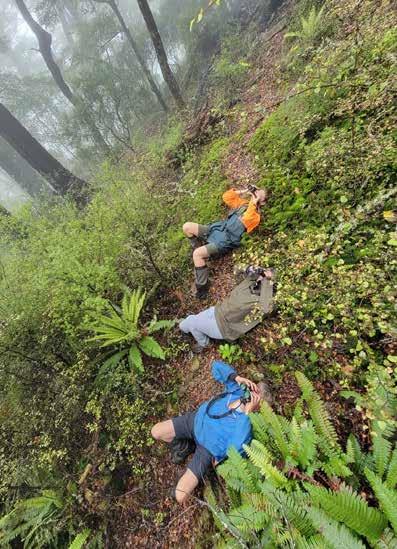
Non council donations/funding $897,153 $1,011,892
Net surplus before depreciation (cash surplus) $203,080 186,308
Membership subscription revenue3 $47,558 $85,504
Total payroll expenditure including ACC and employer Kiiwisaver Contributions
$615,504 $586,942
Non-subsidised payroll expenditure $389,737 $317,417
Subsidised payroll expenditure (inc.ACC and Employer Kiwisaver contributions)
Notes:
$225,767 $269,472
Visitor origin data has only been collected since January 2020
Koha/donations per visitor based on donations received at the Sanctuary Visitor Centre (this revenue is additional to entry fees), entry fees were introduced in Jan. 2020
Excludes business club membership revenue
BROOK WAIMĀRAMA SANCTUARY TRUST ANNUAL REPORT 2021/22 17
1 July 2021–30June 2022 Actual Target Visitors1 •
•
•
•
12,809 13,000 •
3,562 Members (excludes Business Club members) 1386 1200 Volunteers 400+ 400 Conservation count events (note many surveys
event) 4 4 Sanctuary surveys 6 3 Adverse events
to fence 11 4
1
2
3
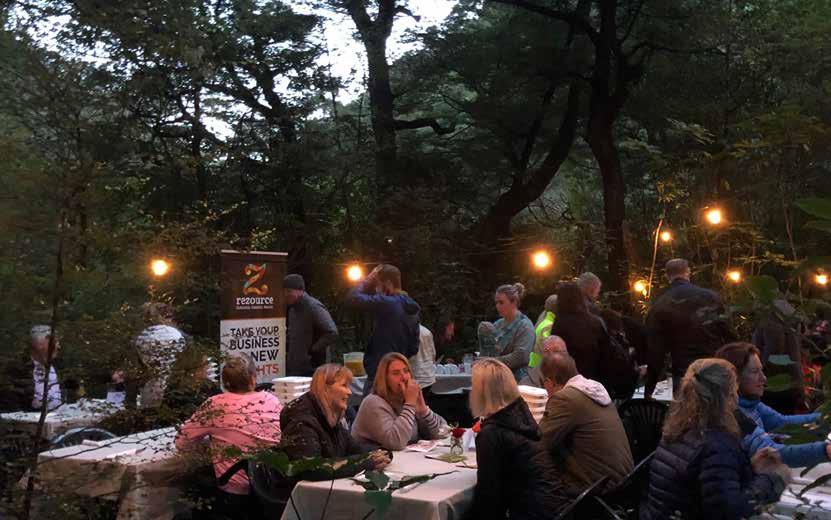
EXPERIENCING NATURE; OUR VISITORS Total: 13,118 | Monthly average: ~1,093 Note; Several months gate sales lost due to Sanctuary closure due to fire risk and COVID19 lockdown requirements. Jul Aug Sep Oct Nov Dec Jan Feb Mar Apr May Jun 3,500 3,000 2,500 2,000 1,500 1,000 500 0 2018-2019 2019-2020 2020-2021 2021-2022 293 434 1,123 588 1,149 2,771 934 861 2,366 886 620 VISITOR ORIGINS JUL21 -JUN 22 18% 82% KIWIS LOCALS 0% INTERNATIONAL 784
FUTURE ACTION
Our annual report aims to not only report on the past year, but also highlight our intentions for the near future. We are making inroads on the four capitals of social, environmental, human, and financial elements and encouraging the community to connect with nature.
The purpose of the Sanctuary deed remains unchanged: to preserve and restore a sustainable natural habitat.
Our immediate aim is to maintain the integrity of our primary asset, the pest fence. We need to enhance the visitor experience by building on initial work developed, such as upgrading the Visitor Centre that has commenced from June 2022. We are looking for opportunities that aid in self sustainability of the Sanctuary and we will be elevating the well-being aspect our Sanctuary offers to the community. We want to keep that momentum going and relationships remain an essential element of Sanctuary support.
The 2020-35 strategic document, outlines our aims and goals including building support for the Sanctuary.
Our people; management and staff
We are building an organisation by empowering our people to make a difference through being part of an effective Sanctuary team. Our key achievements this year reflect the high level of engagement, commitment and hard work of our people in the face of difficult workplace affected by Covid response plans.
Looking forward, the challenges ahead of the Sanctuary include steadily enhance the visitor experience in the Sanctuary. In the next financial year we expect inflationary effects on costs and uncertainty surrounding government funding will put pressure on our annual budget.
 Ru Collin Chief Executive
Ru Collin Chief Executive
BROOK WAIMĀRAMA SANCTUARY TRUST ANNUAL REPORT 2021/22 19
OUR TRUSTEES

Chris Hawkes, Chair, Trustee
Chris has considerable experience in business management including national farmer’s co-ops and international companies ICI and CocaCola. He was 50% owner of Mainstream Food that, originally with eight branches, covered all of the South Island supplying temperaturecontrolled food products to both retail and food service trade. Chris is also Chair of the Kaiteriteri Recreation Reserve Board.
Maurice Woodhouse, Trustee, Treasurer
Maurice Woodhouse has had a long career in the accounting industry and was a founding partner of one of Nelson’s most respected accountancy firms, RWCA. Maurice became a BWST trustee in 2017..
Christine Hemi, Trustee, iwi Representative
Christine Hemi has served in various leadership roles with Ngati Kuia and has been a BWST trustee since 2006.
Paul Russell, Trustee
Paul is a retired consulting Civil Engineer having worked in the Nelson Marlborough region since 1978. He managed the Nelson office of MWH Global for over ten years and during his career worked in Australia, England, Laos, Hongkong, USA and Fiji. Paul was a trustee on the board of Central School, serving 5 years as chairman, and currently is also a Trustee on the Nelson Tasman Housing Trust. Paul has been a BWST trustee since 2017
Debbie Armatage, Trustee
With formal training in journalism, marketing and communications, Debbie has spent many years in the senior management roles predominantly in the food, hospitality, and tourism sectors. Debbie became a BWST trustee in 2019.
Deryk Mason, Trustee, iwi representative Ko Parapara te maunga. Ko Pariwhakaoho te awa. Ko Tokomaru te waka. Ko Ngāti Tama - Te Ātiawa ngā iwi. Ko Meihana taku whānau. Ko taku tūpuna ko Iharaira Meihana. After 25 years on the management team of a global packaging manufacturer in Auckland Deryk returned to Nelson and became a dedicated Sanctuary volunteer for the past seven years with a focus on the biosecurity fence. Derek represents his iwi, Ngāti Tama ki Te Waipounamu and Te Ātiawa o te Waka a Māui on the Trust.
Mike Elson-Brown, Trustee
Mike is a trust and estate practitioner, providing specialist advice to clients in wills, trusts and powers of attorney. Mike joined the BWST as a Trustee in August 2016, stepped down in April 2019 and re-joined the Trust in September 2019.
Mike Glover, Trustee
Mike Glover is a professional director with considerable experience in corporate governance. Mike has an honours degree in law. Mike joined the Trust in August 2019.
20
From Left: Paul Russell, Deryk Mason, Christine Hemi, Chris Hawkes - Chair, Mike Elson-Brown, Maurice Woodhouse, Debbie Armatage & Mike Glover
HEALTH, SAFETY AND WELLBEING (HS&W)
Health and safety are a priority at Brook Waimārama Sanctuary, demonstrated with the formation of a standalone operations committee that reviews HS&W at each meeting and a trust board that lists HS&W as a standing item on its meeting agendas.
The Sanctuary protects our people by doing everything reasonably practicable to minimise or eliminate health and safety risks at work. Our aim is to see everyone go home safely every day and we appreciate the often-unsung efforts our HS&W committee members go to ensuring that aim is met.
Health safety and wellbeing is regulated by an act of parliament and is the responsibility of all trustees, volunteers and staff and is one of the three most significant threats to the success of the Brook Waimārama Sanctuary Trust. The trustees each have equal responsibility to exercise due diligence in understanding how well the trust complies with the Act and whether HS&W performance is satisfactory. The issues that arise in the successful delivery of HS&W are set out in the Act and in simple terms reduce to five requirements:
• Does the BWST have an embedded culture of continuous improvement?
• Is HS&W understood and practised by all BWST personal?
• Are there sufficient resources to deliver HS&W?
• Is there any training required?
• Is data being collected and does it show any more frequent causes of risk exposure that need to be reduced?
The committee has been assigned the responsibilities of The Board which are:
• To ensure the BWST Board complies with its responsibility under the Health and Safety at Work Act. as the Person Controlling the Business or Undertaking (PCBU).
• To carry out the functions of the Health and Safety Committee as defined in the Act.
More generally the Committee aims to ensure the Health and Safety of workers who work for the BWST, and of workers influenced or directed by the BWST. This responsibility extends to other persons to ensure their Health and Safety is not to put at risk from work carried out as part of the conduct of the BWST.
The CE attends meetings and up to two volunteers are invited periodically to observe and contribute. A separate report is submitted to the Board through the CE.
BROOK WAIMĀRAMA SANCTUARY TRUST ANNUAL REPORT 2021/22 21
PERFORMANCE
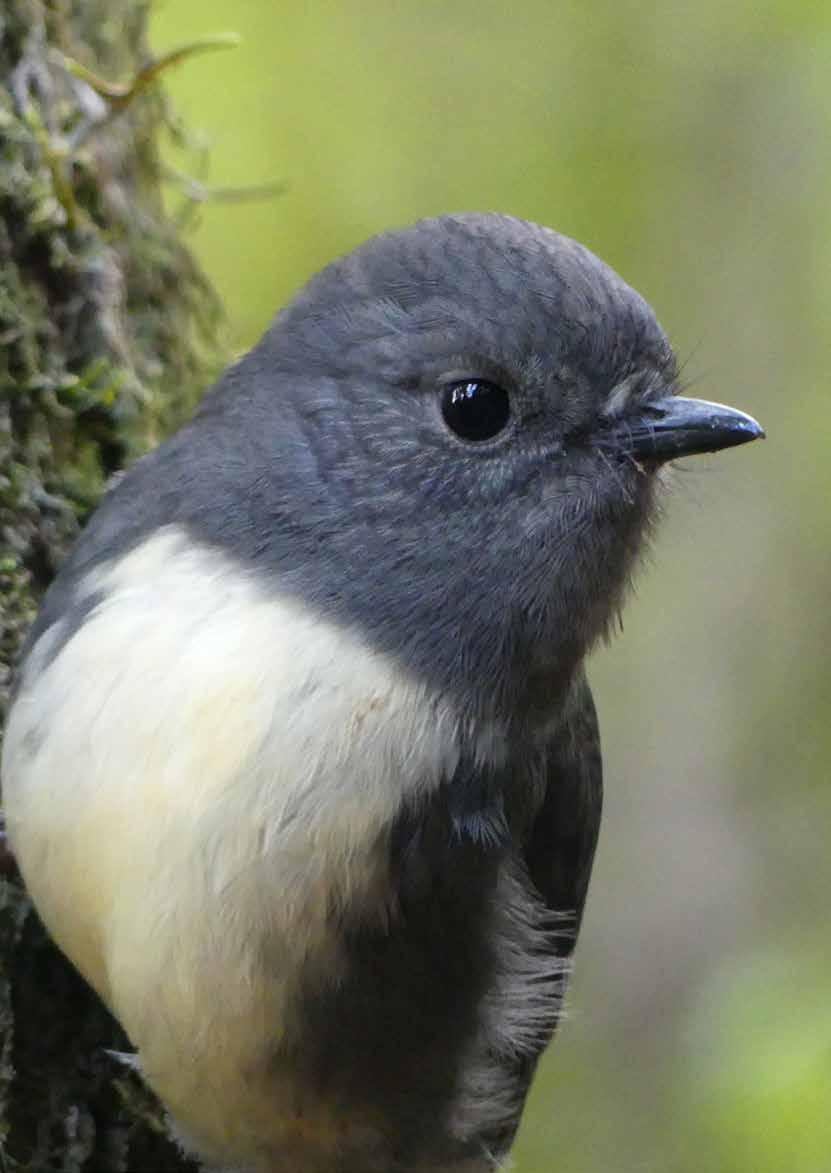
REPORT 2021/22 For the year ended 30 June 2022 - Prepared by RWCA Limited
EntityInformation
TheBrook(Waimarama)SanctuaryTrust Fortheyearended30June2020
LegalNameofEntity:
TheBrook(Waimarama)SanctuaryTrust
OtherNameofEntity
BrookSanctuary
TypeofEntityandLegalBasis
RegisteredCharity
RegistrationNumber: CC32934
Contactdetails
PhysicalAddress: 651BrookStreet,TheBrook,Nelson,7010
PostalAddress: POBox744,Nelson,7040
Phone/Fax: 035462422-CityOffice035394920VisitorCentre
Email/Website: www.brooksanctuary.org/info@brooksanctuary.org
Trustees
ChrisHawkes–Chair MauriceWoodhouse–Treasurer ChristineHemi PaulRussell DeborahArmatage MichaelElson-Brown MichaelGlover DerykMason
Entity'sPurposeorMission:
Vision:TobeNewZealand'srichestconservationenvironmentforvisitors,educationandresearch.
MissionStatement:TheBrook(Waimarama)Sanctuaryisacommunity-ledorganisationcreatingapestfreeecosystemina maturebeechforest.ThepurposesoftheTrustareasfollows:Torestore,toasnaturalstateaspossible,afunctioning ecosystemintheBrookCatchment,Nelson("thesanctuary")withacorridortothecity;tocontroloreliminatepestsfromthe fencedareaofthesanctuary;tocreateaneducationalresource;tocreatepositivevisitorexperiences;todevelopemployment andtrainingopportunities;tointroducelostspeciesbackintothesanctuary;andgenerallytodoorperformsuchacts,matters orthingsasmaybeincidentalorconducivetotheattainmentofanyortheforegoingobjects.
EntityStructure:
TheBoardofTrusteesiscomprisedofnolessthanfive(5)trusteesandnomorethanfifteen(15)trustees.Thecurrentnumberof theboardiseight(8)withChrisHawkesastheelectedChairpersonandMauriceWoodhouseastheelectedTreasurer.”
Trusteesholdofficeforatermnotexceedingthree(3)yearsfromthedateofappointmentandthereafterareeligiblefor reappointmentforafurtherterm(s). Thereisacurrentstaff(asof30June2020)of4.6FTEsmadeupofChiefExecutive; OperationsManager;FieldOperationsCoordinator,EcosystemRanger, OfficeManager.EmployeesreporttotheChiefExecutive andOperationsManager.TheChiefExecutive,OperationsManagerandOfficeManagerprovidewrittenmonthlyreportstothe

BROOK WAIMĀRAMA SANCTUARY TRUST ANNUAL REPORT 2021/22 23 PerformanceReport TheBrook(Waimarama)SanctuaryTrust Page3of23
24 Entity Information 26 Approval of Performance Report 27 Statement of Service Performance 29 Statement of Cash Flows 30 Statement of Financial Performance 32 Statement of Financial Position 33 Statement of Changes in General Funds 34 Depreciation Schedule 39 Notes to the Performance Report 43 Auditor’s Report Photo: Andrew MacDonald
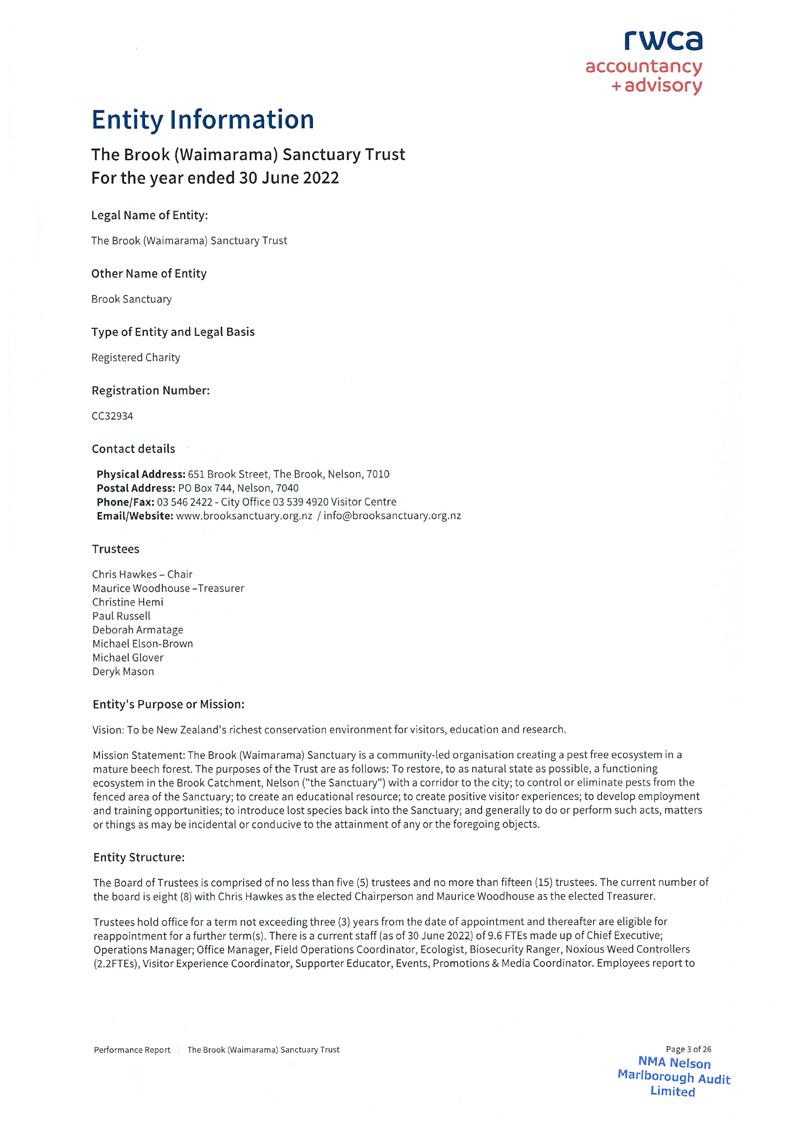
NAME COST OPENINGVALUE PURCHASES DISPOSALS RATE METHOD
Signage 1,500 10.00% SL Signage2007 1,219 10.00% SL
TadorPhone(TelephoneSystems) 1,586 1,015 36.00% SL TradeSiteBoxes 1,368 137 30.00% SL
Transmitter-Rotary 6,493 30.00% SL Traps 21,271 10.00% SL Traps2007 955 10.00% SL Traps2010 2,086 68 10.00% SL Traps2016 4,870 3,125 10.00% SL Yamaha-2800wInverter 2,278 699 16.00% SL
TotalPlant&Equipment-atCost 130,631 26,786 3,066
Total 5,290,987 4,540,228 210,384 4,492
Theaccompanyingnotesandauditor'sreportformpartofthesefinancialstatements.
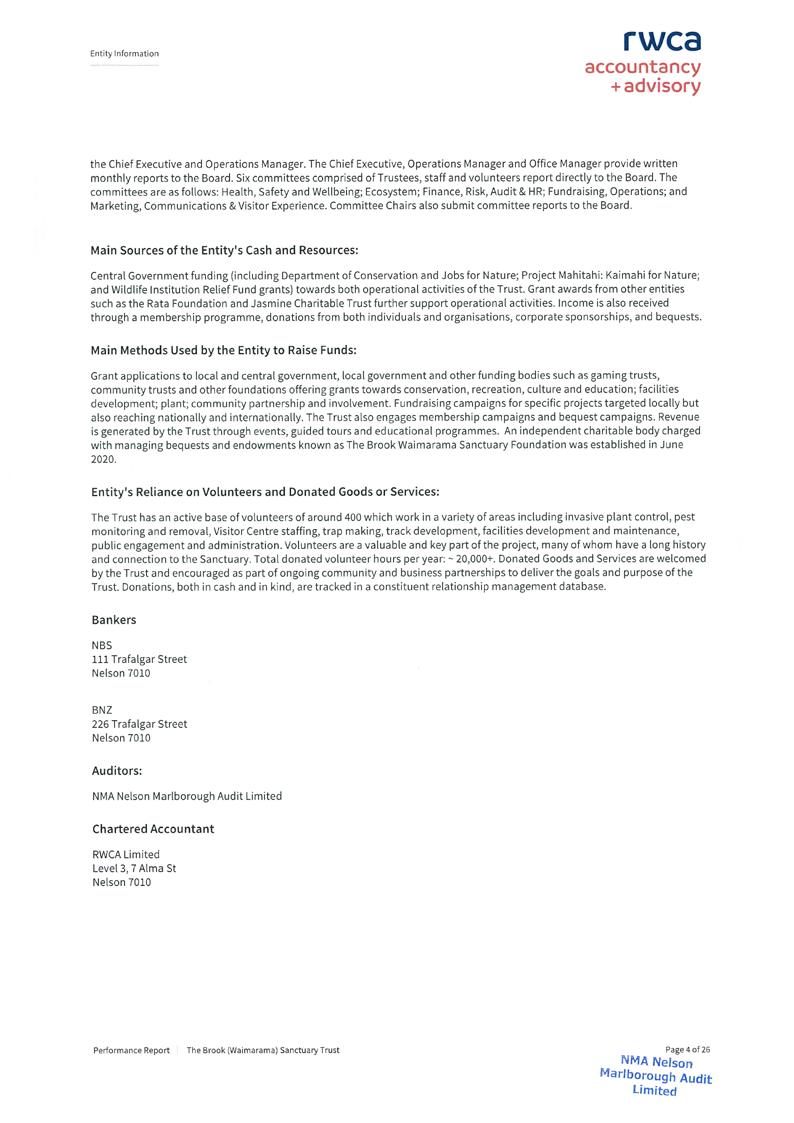
DepreciationSchedule
PerformanceReport TheBrook(Waimarama)SanctuaryTrust
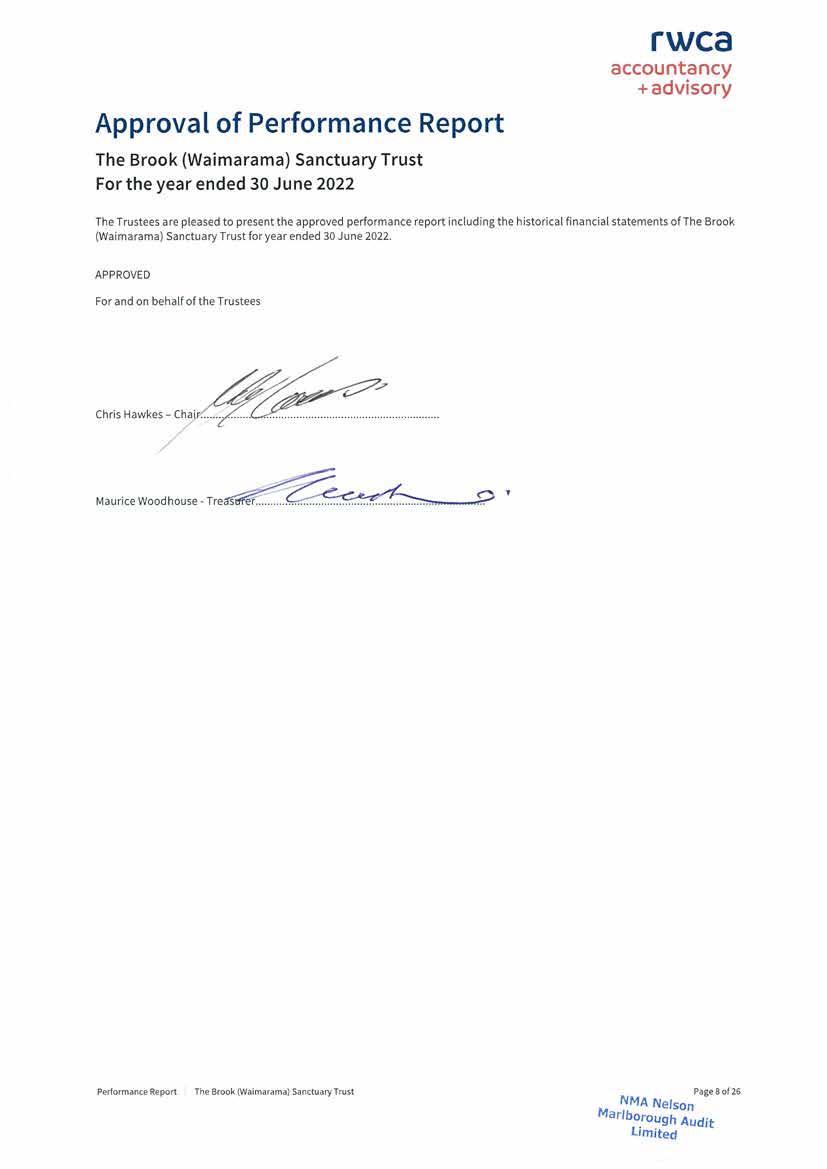
TheBrook(Waimarama)SanctuaryTrust
NAME COST OPENINGVALUE PURCHASES DISPOSALS RATE METHOD
Signage 1,500 10.00% SL Signage2007 1,219 10.00% SL
TadorPhone(TelephoneSystems) 1,586 1,015 36.00% SL
TradeSiteBoxes 1,368 137 30.00% SL
Transmitter-Rotary 6,493 30.00% SL Traps 21,271 10.00% SL Traps2007 955 10.00% SL Traps2010 2,086 68 10.00% SL Traps2016 4,870 3,125 10.00% SL Yamaha-2800wInverter 2,278 699 16.00% SL
TotalPlant&Equipment-atCost 130,631 26,786 3,066
Total 5,290,987 4,540,228 210,384 4,492
Theaccompanyingnotesandauditor'sreportformpartofthesefinancialstatements.
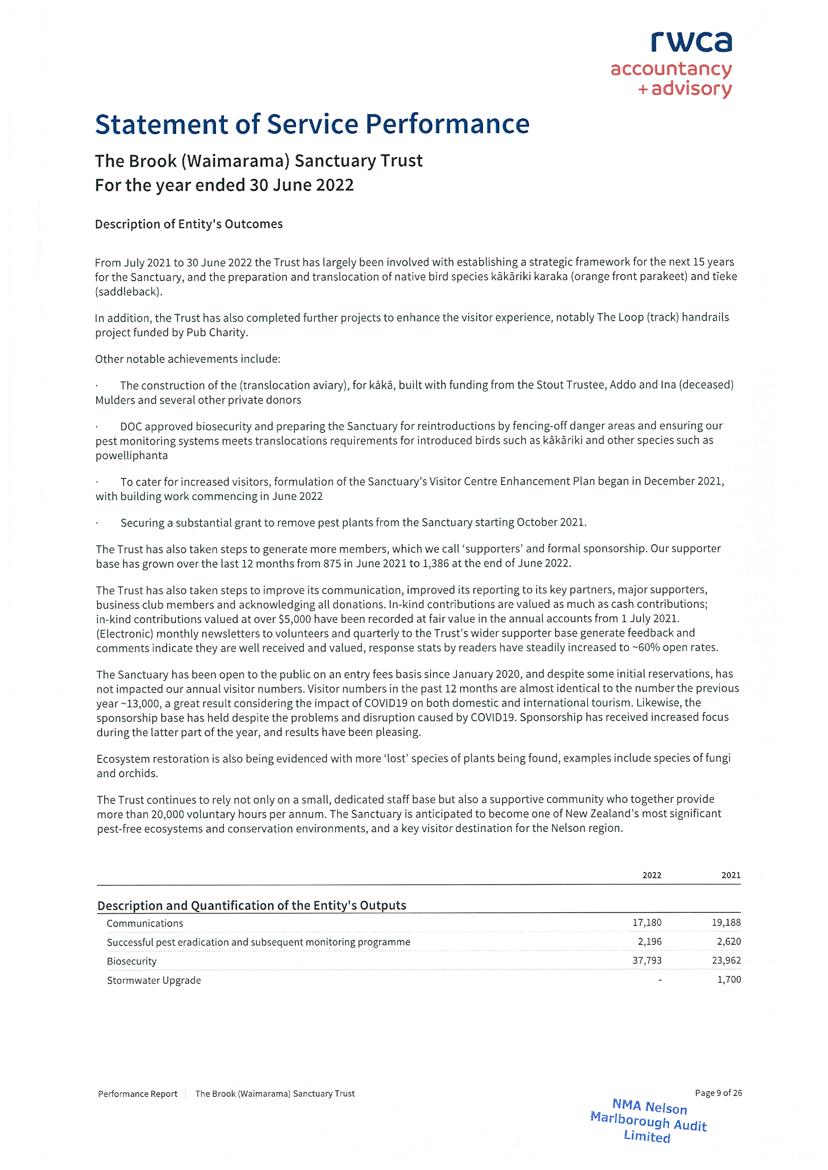
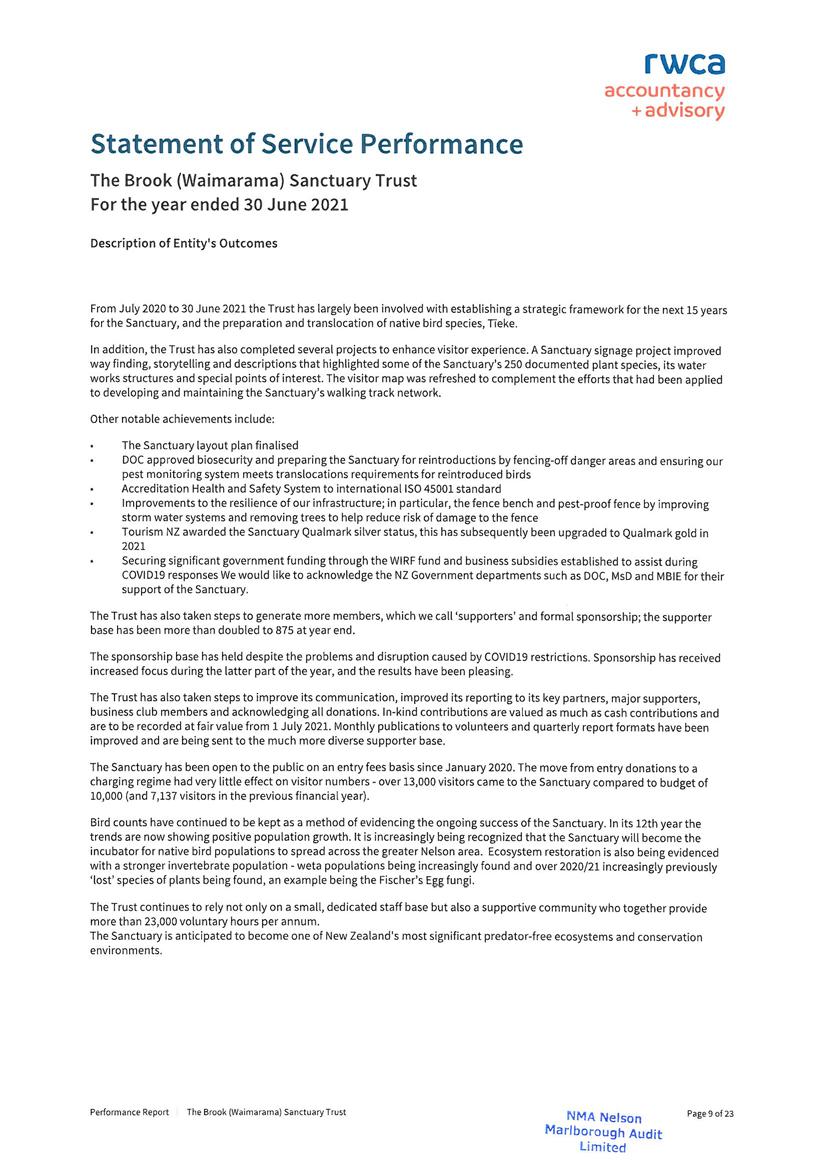
DepreciationSchedule
PerformanceReport TheBrook(Waimarama)SanctuaryTrust
NAME COST OPENINGVALUE PURCHASES DISPOSALS RATE METHOD
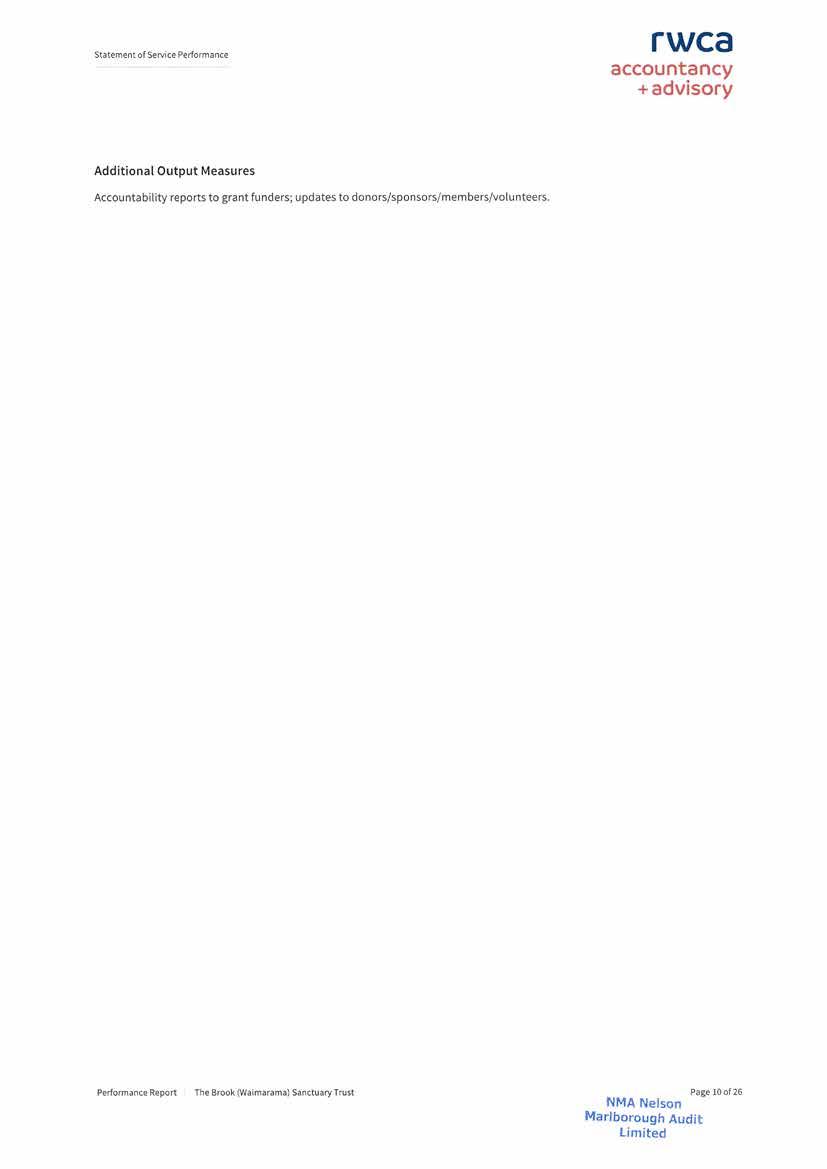
Signage 1,500 10.00% SL Signage2007 1,219 10.00% SL
TadorPhone(TelephoneSystems) 1,586 1,015 36.00% SL TradeSiteBoxes 1,368 137 30.00% SL
Transmitter-Rotary 6,493 30.00% SL Traps 21,271 10.00% SL Traps2007 955 10.00% SL Traps2010 2,086 68 10.00% SL Traps2016 4,870 3,125 10.00% SL Yamaha-2800wInverter 2,278 699 16.00% SL
TotalPlant&Equipment-atCost 130,631 26,786 3,066
Total 5,290,987 4,540,228 210,384 4,492
Theaccompanyingnotesandauditor'sreportformpartofthesefinancialstatements.
DepreciationSchedule
PerformanceReport TheBrook(Waimarama)SanctuaryTrust
NAME COST OPENINGVALUE PURCHASES DISPOSALS RATE METHOD
Signage 1,500 10.00% SL Signage2007 1,219 10.00% SL
TadorPhone(TelephoneSystems) 1,586 1,015 36.00% SL
TradeSiteBoxes 1,368 137 30.00% SL
Transmitter-Rotary 6,493 30.00% SL Traps 21,271 10.00% SL Traps2007 955 10.00% SL Traps2010 2,086 68 10.00% SL Traps2016 4,870 3,125 10.00% SL Yamaha-2800wInverter 2,278 699 16.00% SL
TotalPlant&Equipment-atCost 130,631 26,786 3,066

Total 5,290,987 4,540,228 210,384 4,492
Theaccompanyingnotesandauditor'sreportformpartofthesefinancialstatements.
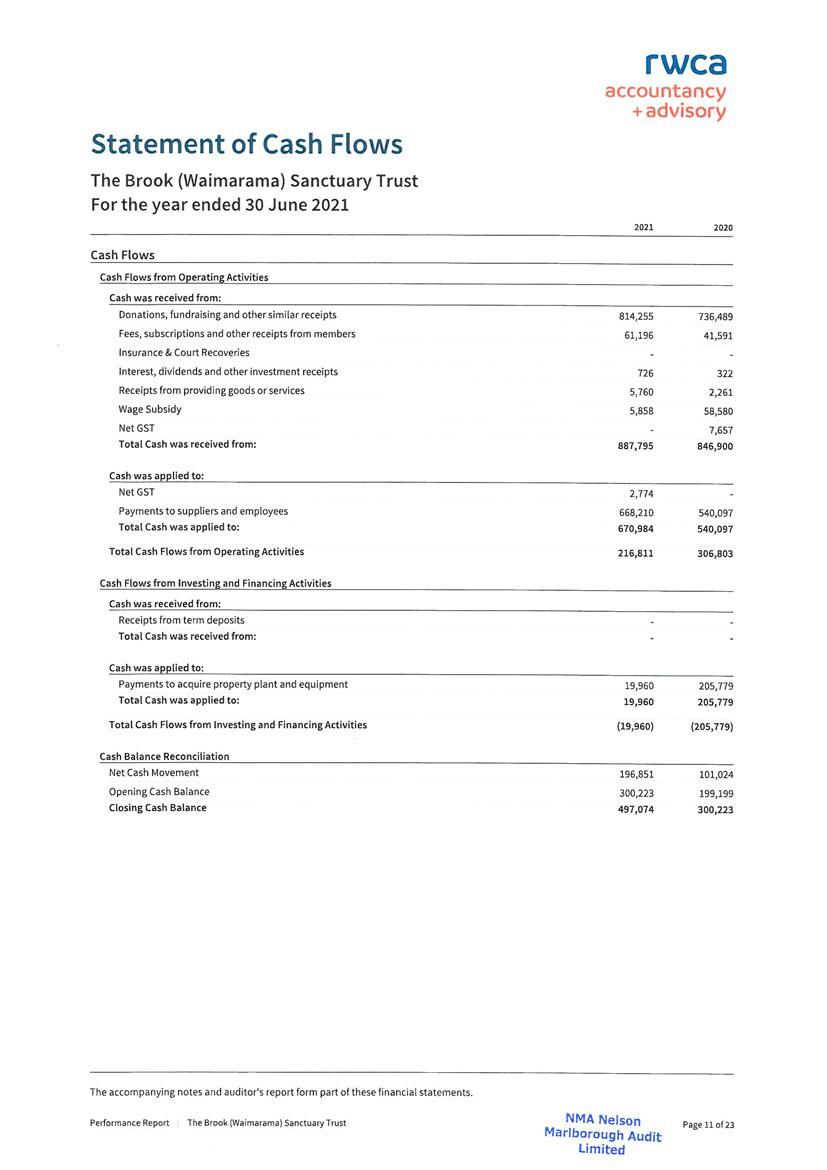
DepreciationSchedule
PerformanceReport TheBrook(Waimarama)SanctuaryTrust
NAME COST OPENINGVALUE PURCHASES DISPOSALS RATE METHOD
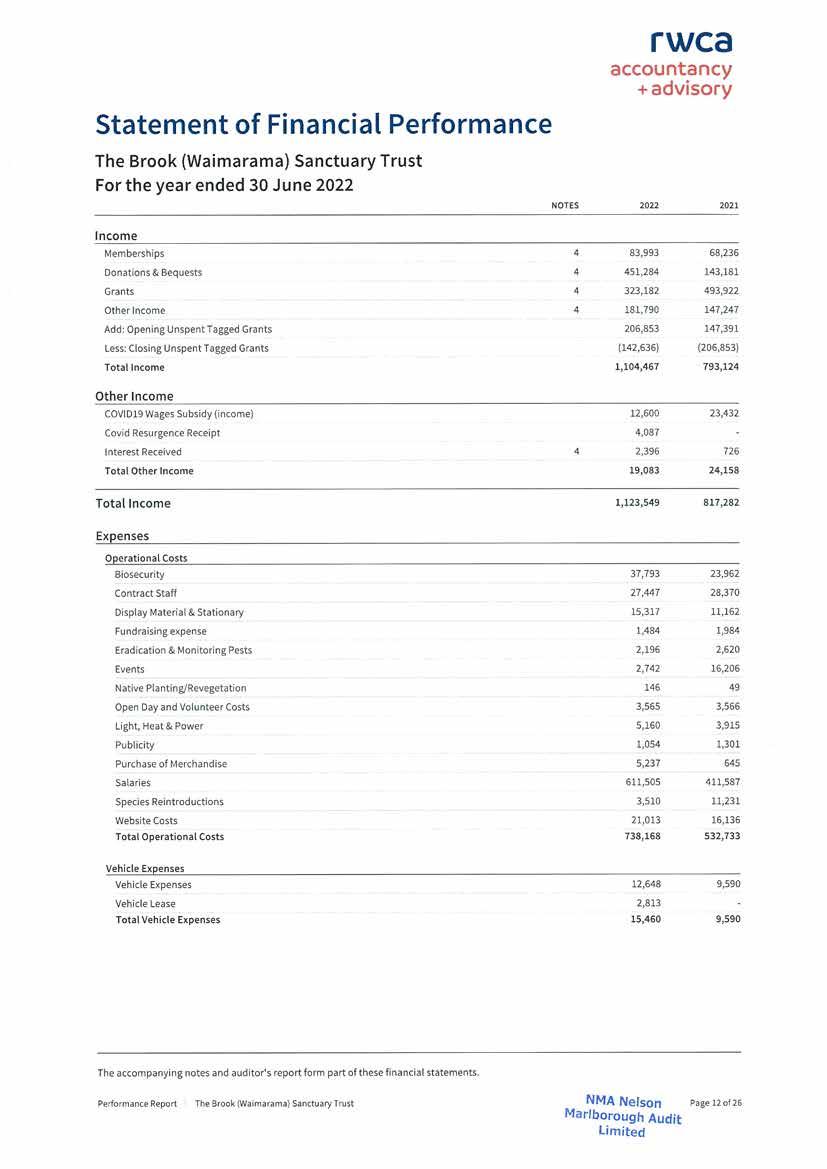
Signage 1,500 10.00% SL Signage2007 1,219 10.00% SL
TadorPhone(TelephoneSystems) 1,586 1,015 36.00% SL TradeSiteBoxes 1,368 137 30.00% SL
Transmitter-Rotary 6,493 30.00% SL Traps 21,271 10.00% SL Traps2007 955 10.00% SL Traps2010 2,086 68 10.00% SL Traps2016 4,870 3,125 10.00% SL Yamaha-2800wInverter 2,278 699 16.00% SL
TotalPlant&Equipment-atCost 130,631 26,786 3,066
Total 5,290,987 4,540,228 210,384 4,492
Theaccompanyingnotesandauditor'sreportformpartofthesefinancialstatements.
DepreciationSchedule
PerformanceReport TheBrook(Waimarama)SanctuaryTrust
NAME COST OPENINGVALUE PURCHASES DISPOSALS RATE METHOD

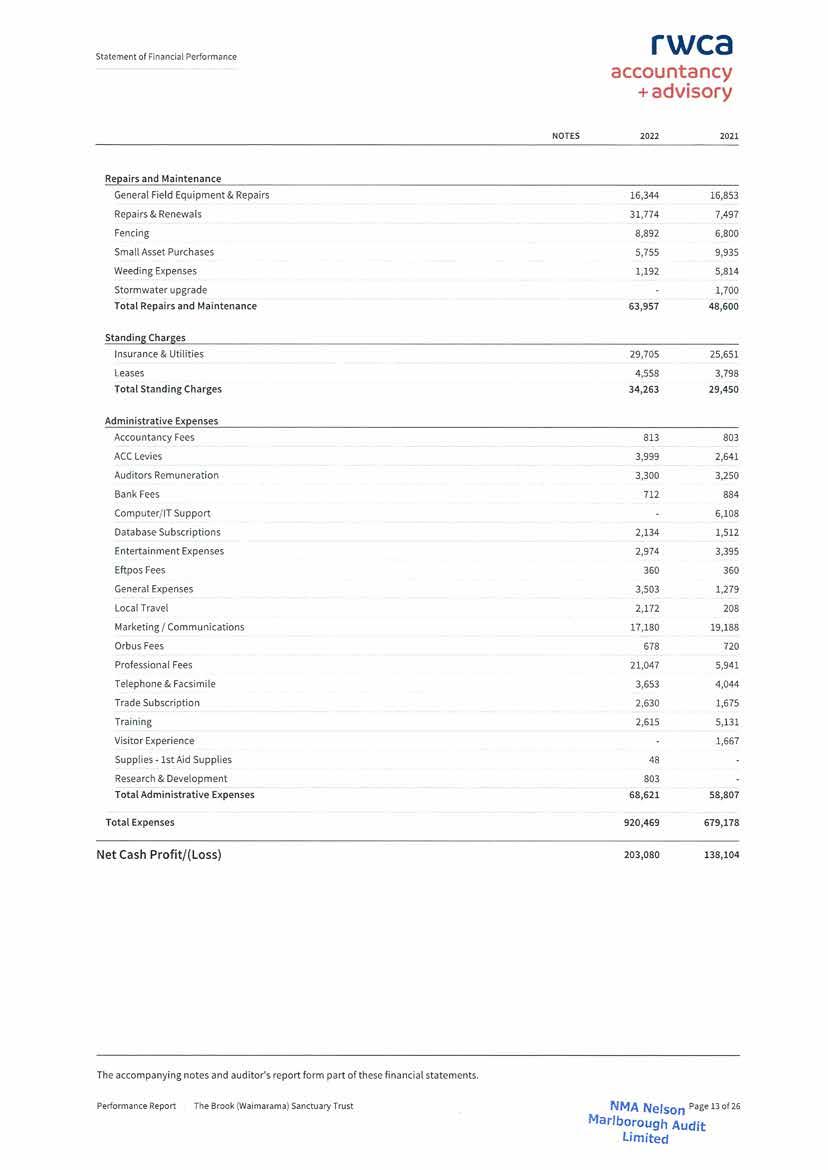
Signage 1,500 10.00% SL Signage2007 1,219 10.00% SL
TadorPhone(TelephoneSystems) 1,586 1,015 36.00% SL
TradeSiteBoxes 1,368 137 30.00% SL
Transmitter-Rotary 6,493 30.00% SL Traps 21,271 10.00% SL Traps2007 955 10.00% SL Traps2010 2,086 68 10.00% SL Traps2016 4,870 3,125 10.00% SL Yamaha-2800wInverter 2,278 699 16.00% SL
TotalPlant&Equipment-atCost 130,631 26,786 3,066
Total 5,290,987 4,540,228 210,384 4,492
DepreciationSchedule
TheBrook(Waimarama)SanctuaryTrust
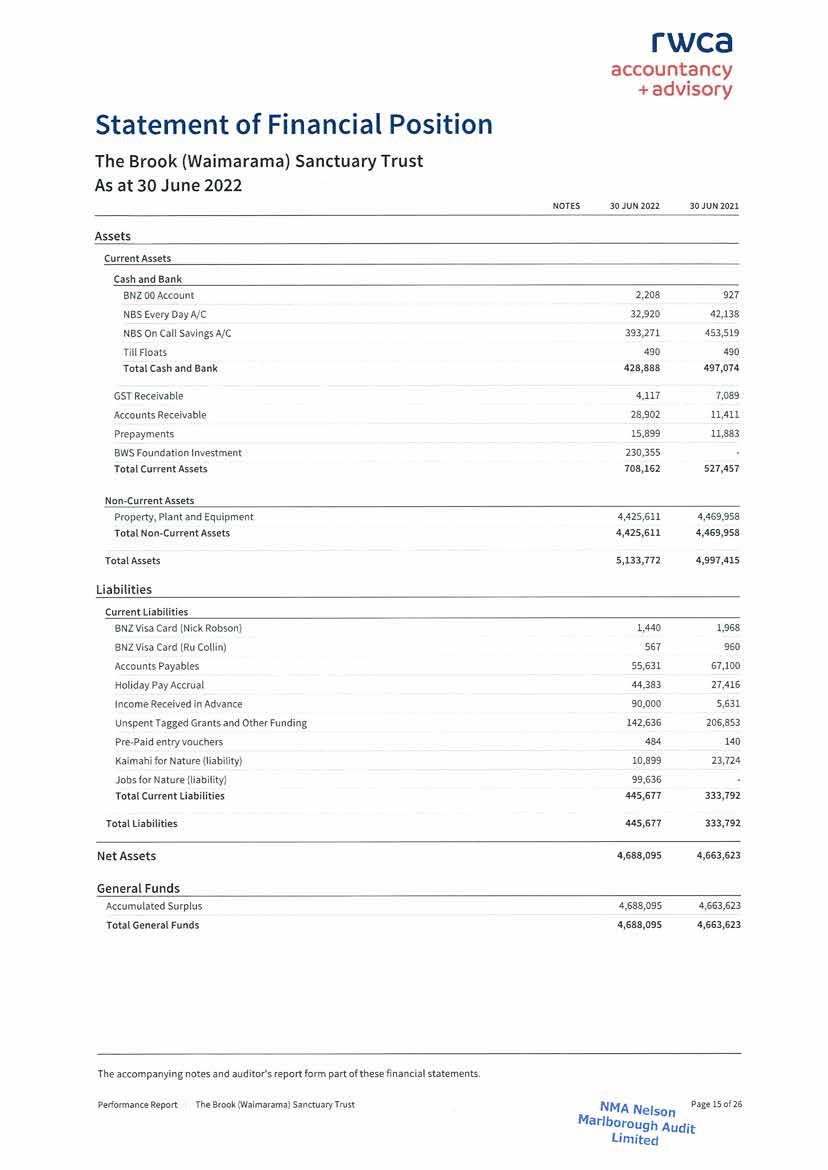
NAME COST OPENINGVALUE PURCHASES DISPOSALS RATE METHOD
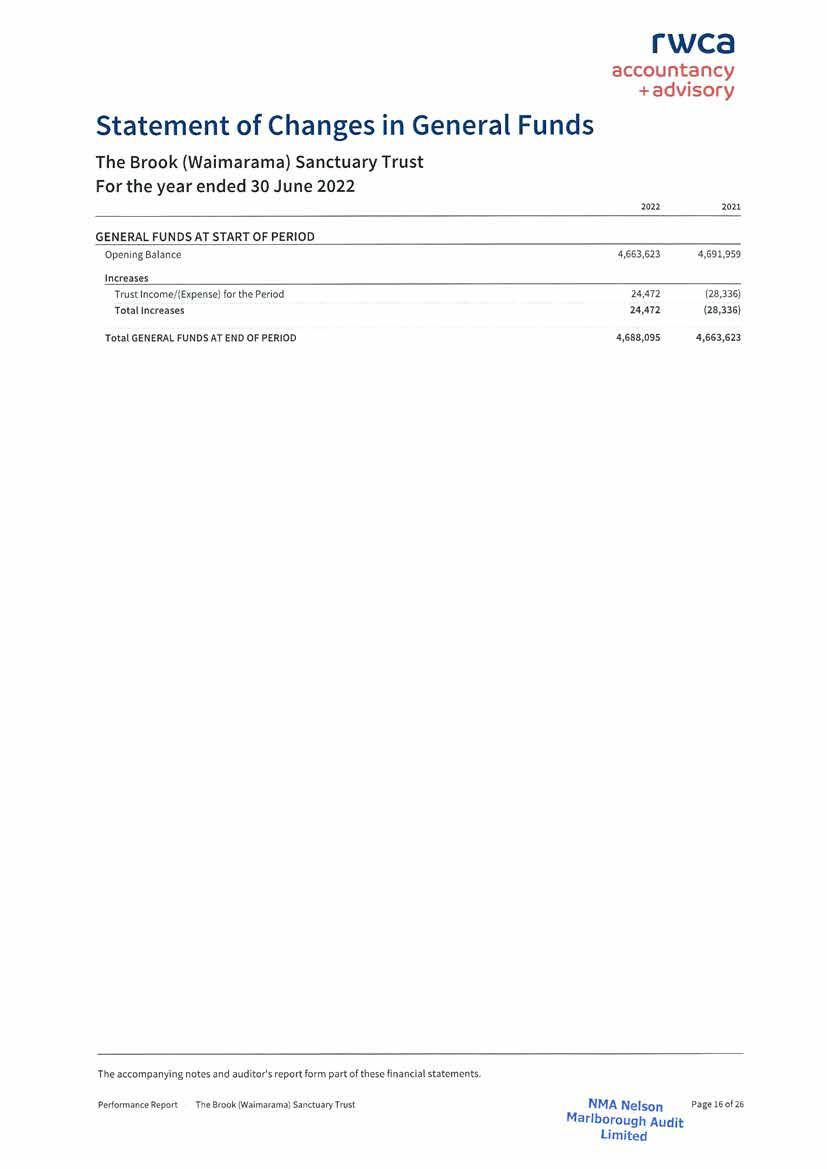
Signage 1,500 10.00% SL Signage2007 1,219 10.00% SL
TadorPhone(TelephoneSystems) 1,586 1,015 36.00% SL TradeSiteBoxes 1,368 137 30.00% SL
Transmitter-Rotary 6,493 30.00% SL Traps 21,271 10.00% SL Traps2007 955 10.00% SL Traps2010 2,086 68 10.00% SL Traps2016 4,870 3,125 10.00% SL Yamaha-2800wInverter 2,278 699 16.00% SL
TotalPlant&Equipment-atCost 130,631 26,786 3,066
Total 5,290,987 4,540,228 210,384 4,492
Theaccompanyingnotesandauditor'sreportformpartofthesefinancialstatements.
DepreciationSchedule
PerformanceReport TheBrook(Waimarama)SanctuaryTrust

DEPRECIATION

DEP
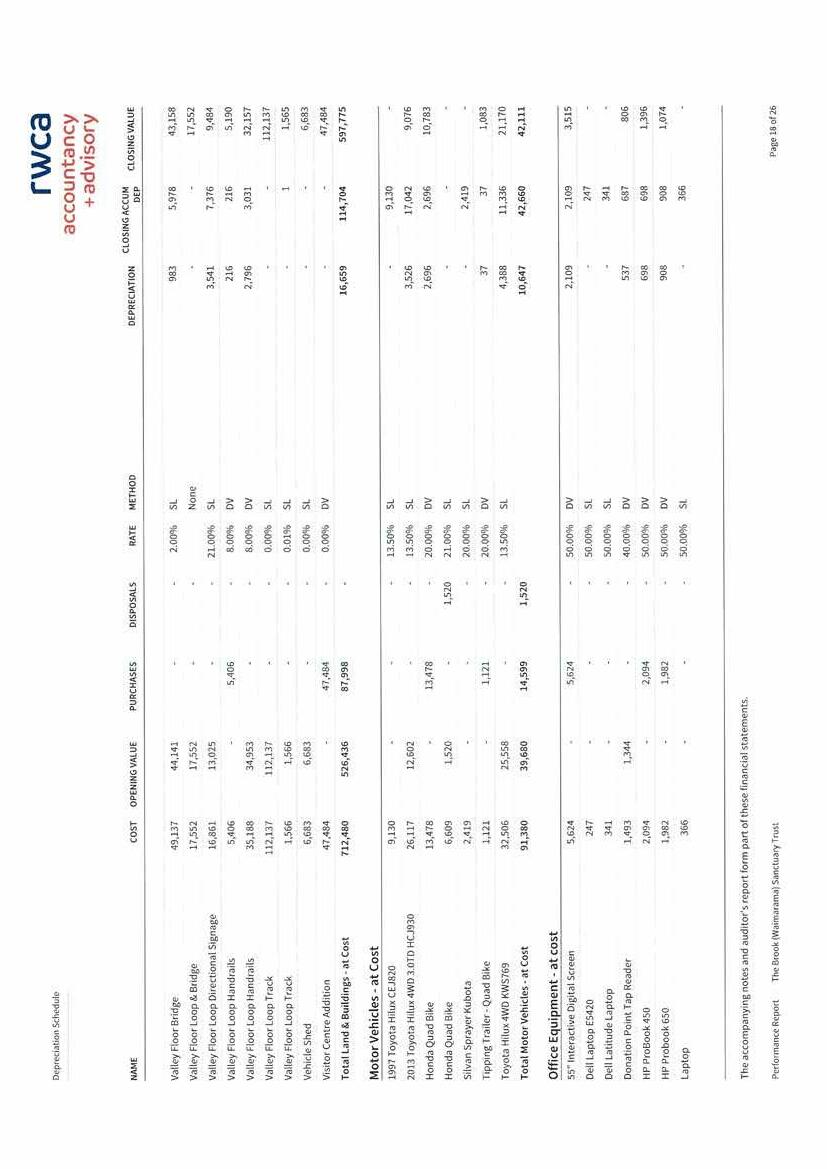
DepreciationSchedule NAME COST OPENINGVALUE PURCHASES DISPOSALS RATE METHOD
CLOSINGACCUM
CLOSINGVALUE Theaccompanyingnotesandauditor'sreportformpartofthesefinancialstatements. PerformanceReport TheBrook(Waimarama)SanctuaryTrust Page19of23 Signage 1,500 10.00% SL 1,500 Signage2007 1,219 10.00% SL 1,219 TadorPhone(TelephoneSystems) 1,586 1,015 36.00% SL 571 1,142 444 TradeSiteBoxes 1,368 137 30.00% SL 137 1,368 Transmitter-Rotary 6,493 30.00% SL 6,493 Traps 21,271 10.00% SL 21,271 Traps2007 955 10.00% SL 955 Traps2010 2,086 68 10.00% SL 68 2,086 Traps2016 4,870 3,125 10.00% SL 487 2,232 2,638 Yamaha-2800wInverter 2,278 699 16.00% SL 365 1,944 334 TotalPlant&Equipment-atCost 130,631 26,786 3,066 7,614 108,392 22,239 Total 5,290,987 4,540,228 210,384 4,492 158,026 675,943 4,588,095
DEPRECIATION

DEP
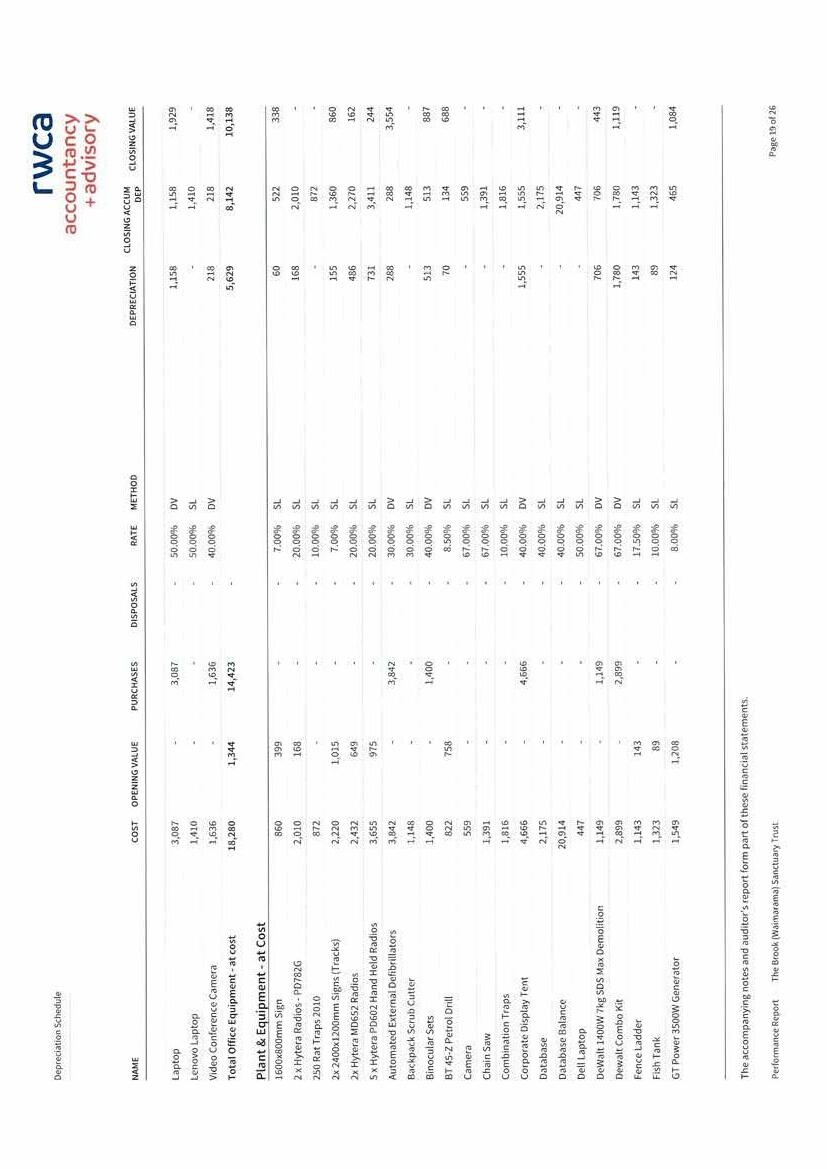
DepreciationSchedule NAME COST OPENINGVALUE PURCHASES DISPOSALS RATE METHOD
CLOSINGACCUM
CLOSINGVALUE Theaccompanyingnotesandauditor'sreportformpartofthesefinancialstatements. PerformanceReport TheBrook(Waimarama)SanctuaryTrust Page19of23 Signage 1,500 10.00% SL 1,500 Signage2007 1,219 10.00% SL 1,219 TadorPhone(TelephoneSystems) 1,586 1,015 36.00% SL 571 1,142 444 TradeSiteBoxes 1,368 137 30.00% SL 137 1,368 Transmitter-Rotary 6,493 30.00% SL 6,493 Traps 21,271 10.00% SL 21,271 Traps2007 955 10.00% SL 955 Traps2010 2,086 68 10.00% SL 68 2,086 Traps2016 4,870 3,125 10.00% SL 487 2,232 2,638 Yamaha-2800wInverter 2,278 699 16.00% SL 365 1,944 334 TotalPlant&Equipment-atCost 130,631 26,786 3,066 7,614 108,392 22,239 Total 5,290,987 4,540,228 210,384 4,492 158,026 675,943 4,588,095
DEPRECIATION

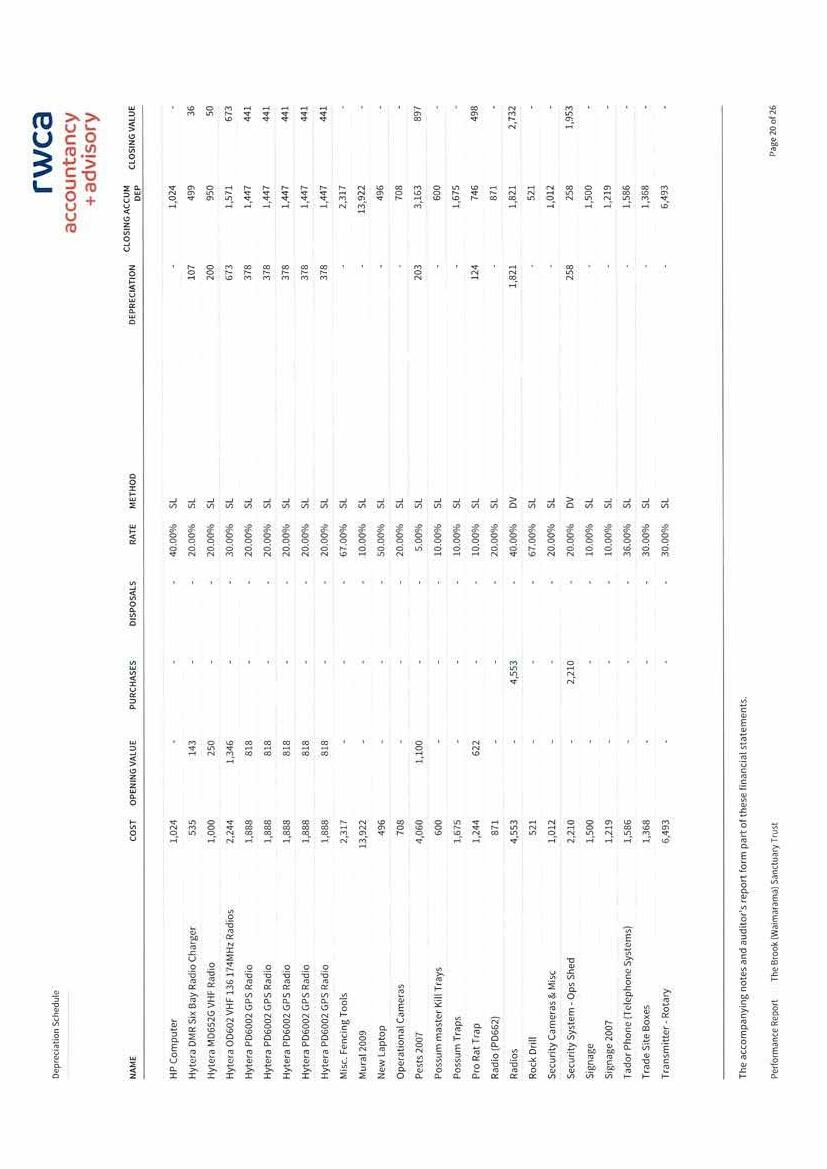
DepreciationSchedule NAME COST OPENINGVALUE PURCHASES DISPOSALS RATE METHOD
CLOSINGACCUM DEP CLOSINGVALUE Theaccompanyingnotesandauditor'sreportformpartofthesefinancialstatements. PerformanceReport TheBrook(Waimarama)SanctuaryTrust Page19of23 Signage 1,500 10.00% SL 1,500 Signage2007 1,219 10.00% SL 1,219 TadorPhone(TelephoneSystems) 1,586 1,015 36.00% SL 571 1,142 444 TradeSiteBoxes 1,368 137 30.00% SL 137 1,368 Transmitter-Rotary 6,493 30.00% SL 6,493 Traps 21,271 10.00% SL 21,271 Traps2007 955 10.00% SL 955 Traps2010 2,086 68 10.00% SL 68 2,086 Traps2016 4,870 3,125 10.00% SL 487 2,232 2,638 Yamaha-2800wInverter 2,278 699 16.00% SL 365 1,944 334 TotalPlant&Equipment-atCost 130,631 26,786 3,066 7,614 108,392 22,239 Total 5,290,987 4,540,228 210,384 4,492 158,026 675,943 4,588,095

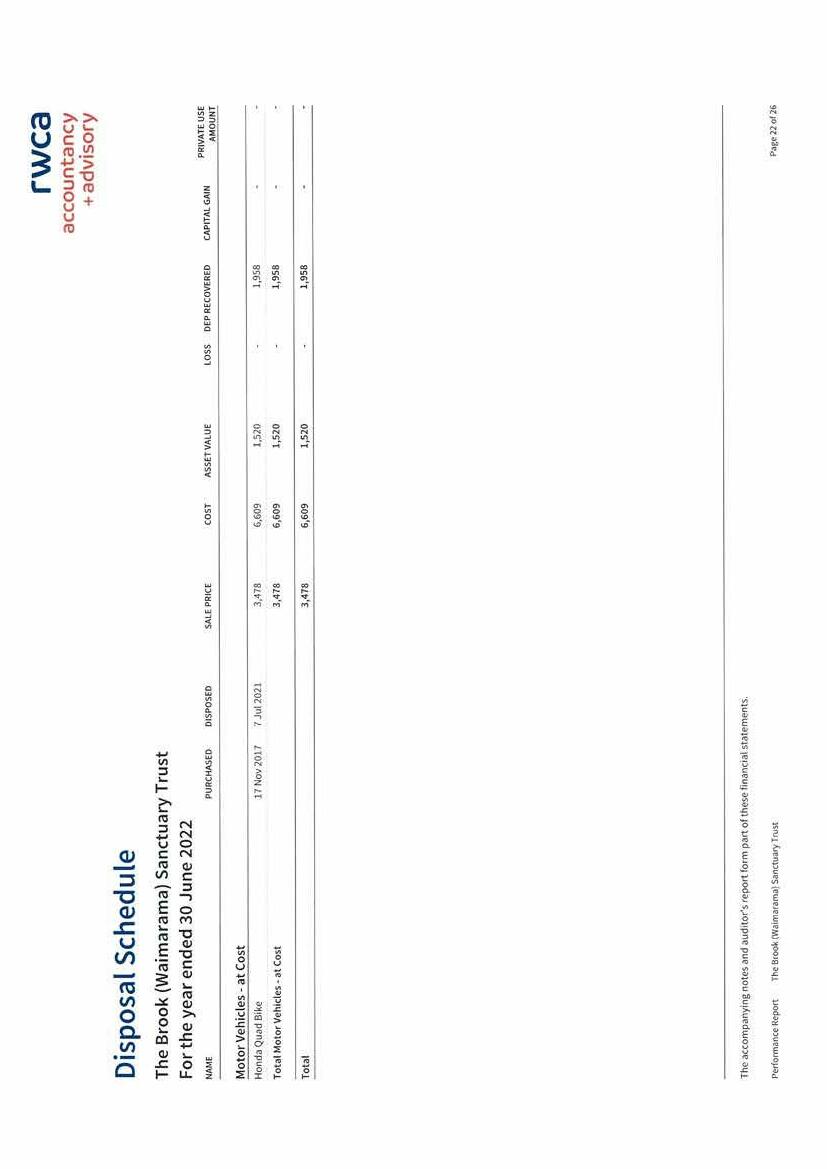
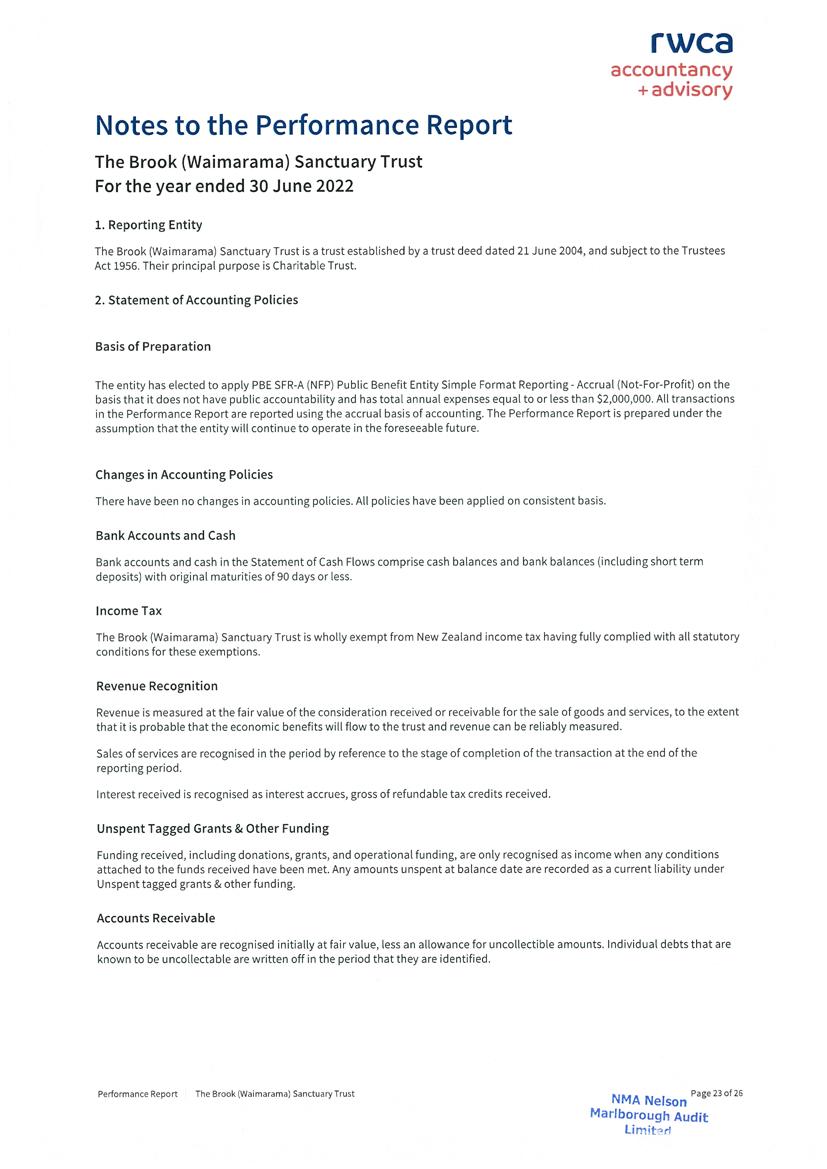
NAME COST OPENINGVALUE PURCHASES DISPOSALS RATE METHOD
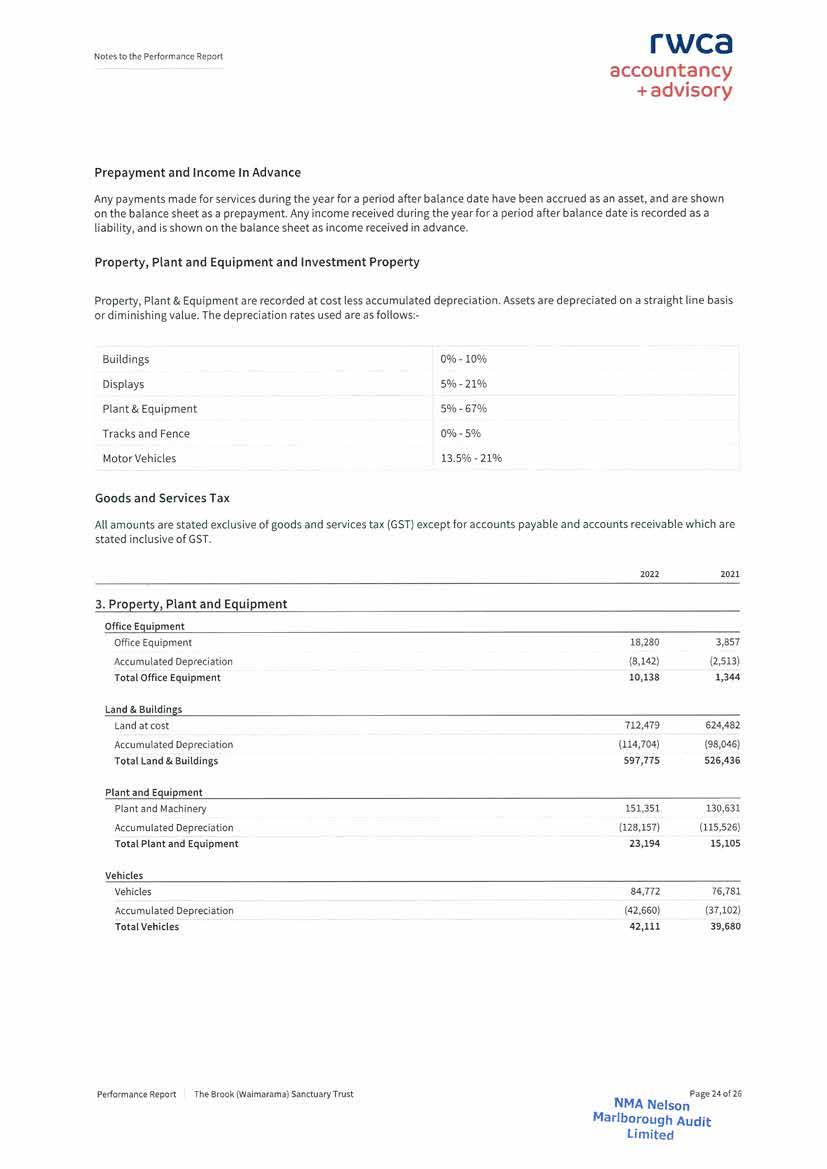
Signage 1,500 10.00% SL Signage2007 1,219 10.00% SL
TadorPhone(TelephoneSystems) 1,586 1,015 36.00% SL TradeSiteBoxes 1,368 137 30.00% SL
Transmitter-Rotary 6,493 30.00% SL Traps 21,271 10.00% SL Traps2007 955 10.00% SL Traps2010 2,086 68 10.00% SL Traps2016 4,870 3,125 10.00% SL Yamaha-2800wInverter 2,278 699 16.00% SL
TotalPlant&Equipment-atCost 130,631 26,786 3,066
Total 5,290,987 4,540,228 210,384 4,492
Theaccompanyingnotesandauditor'sreportformpartofthesefinancialstatements.
DepreciationSchedule
PerformanceReport TheBrook(Waimarama)SanctuaryTrust
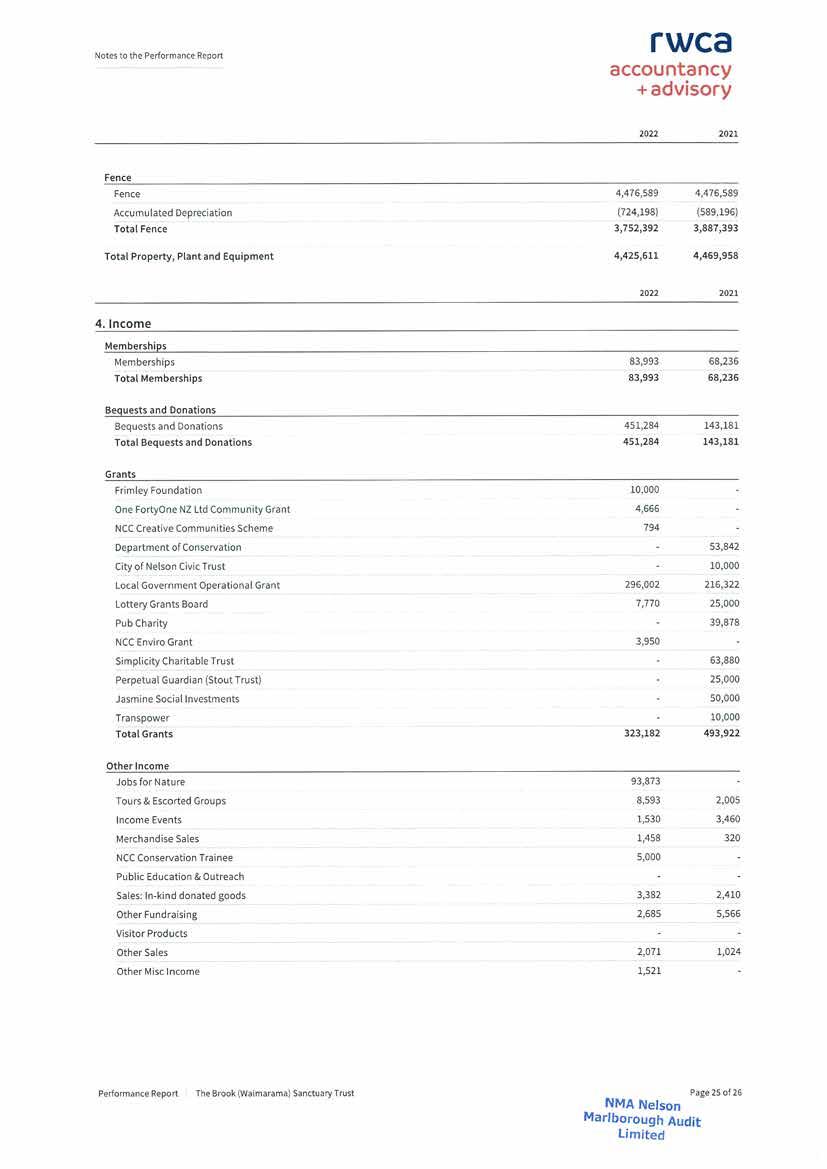
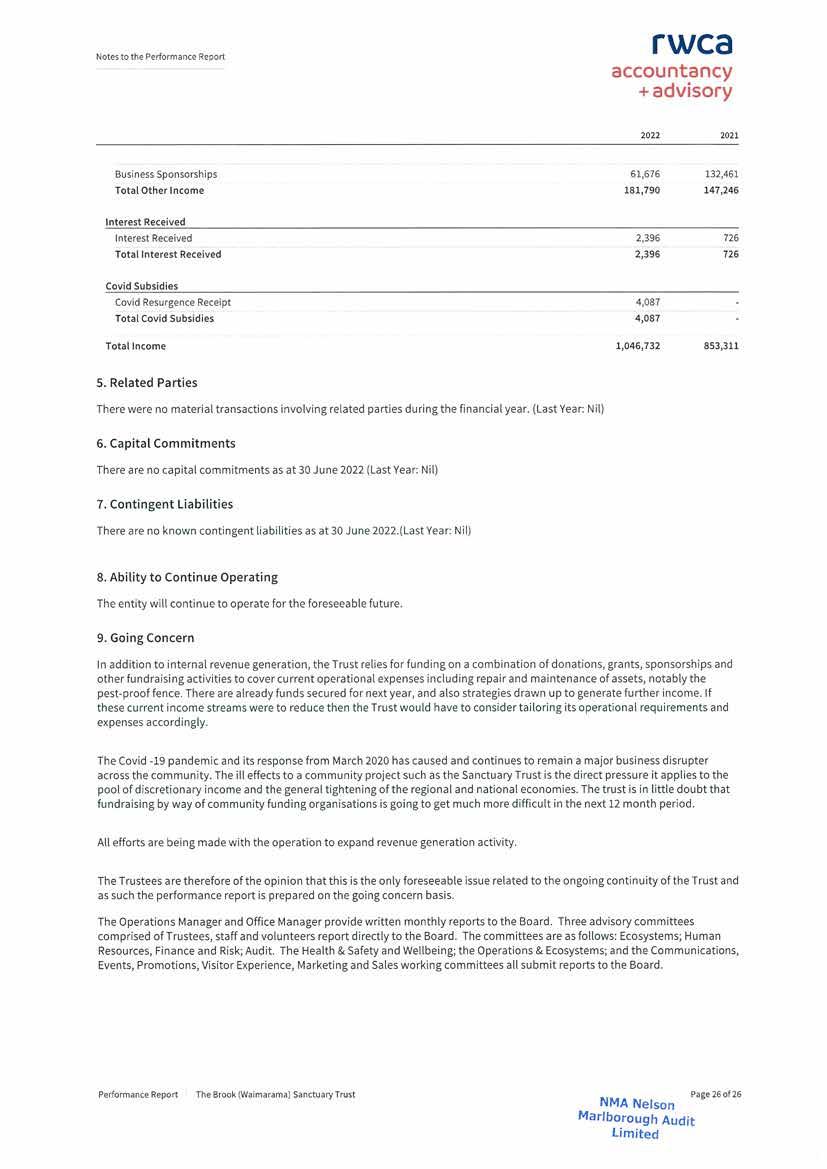
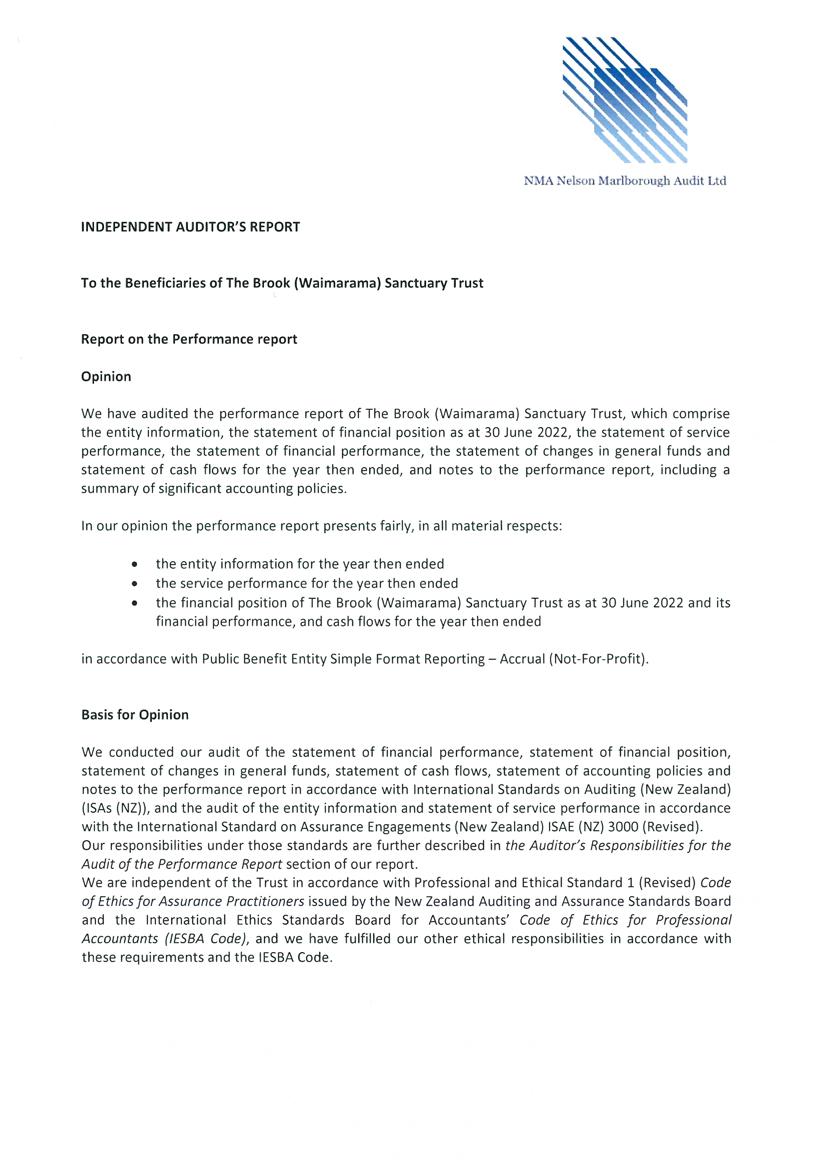
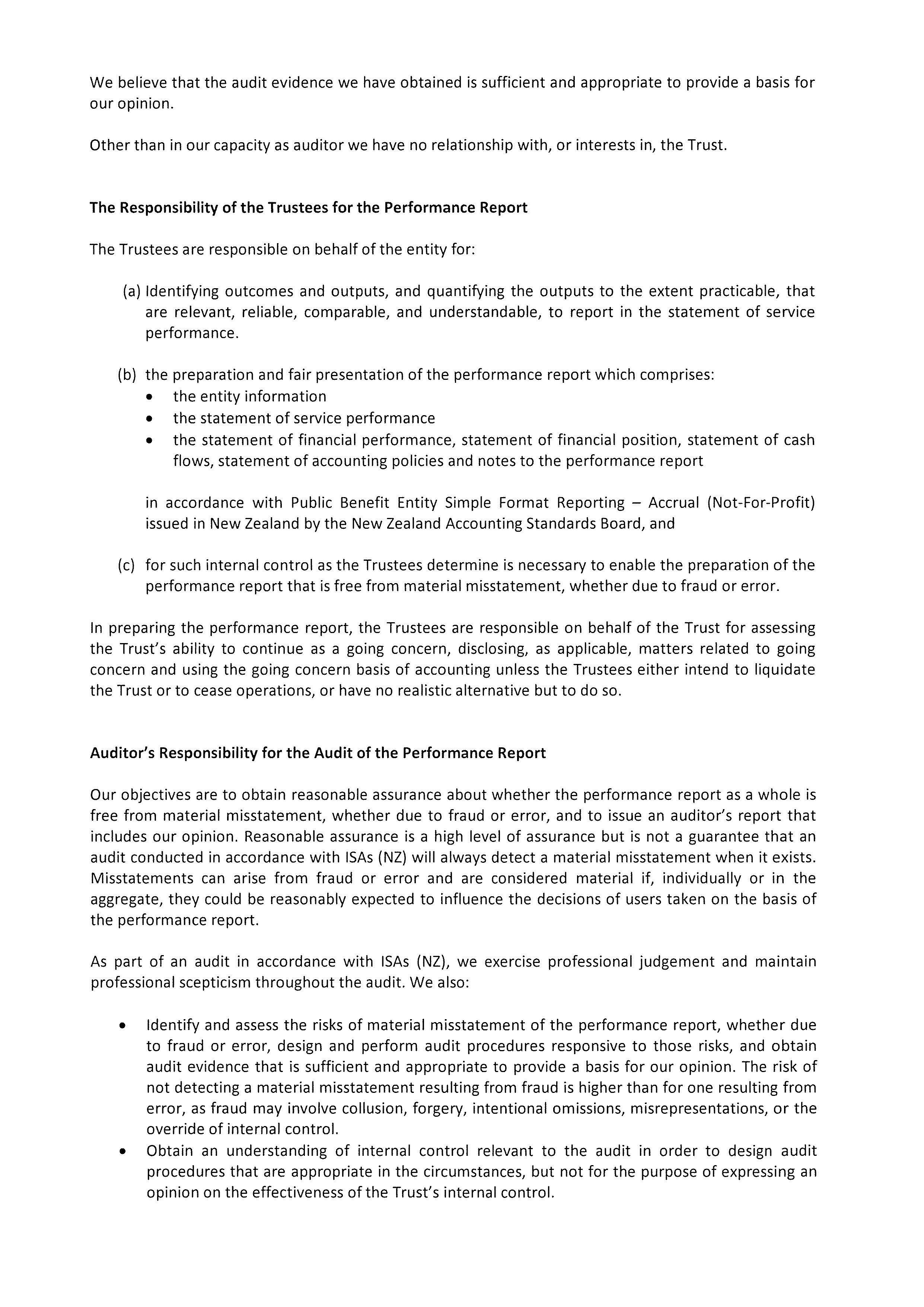
44

BROOK WAIMĀRAMA SANCTUARY TRUST ANNUAL REPORT 2021/22 45
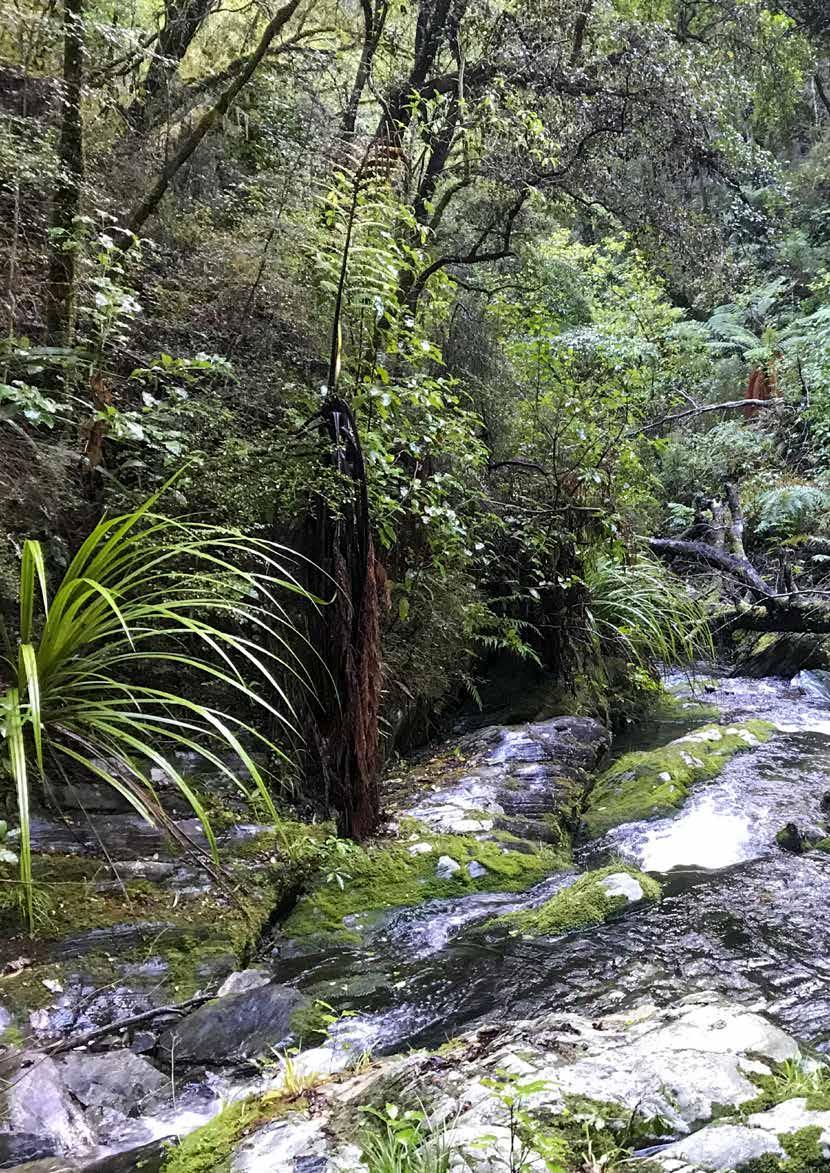

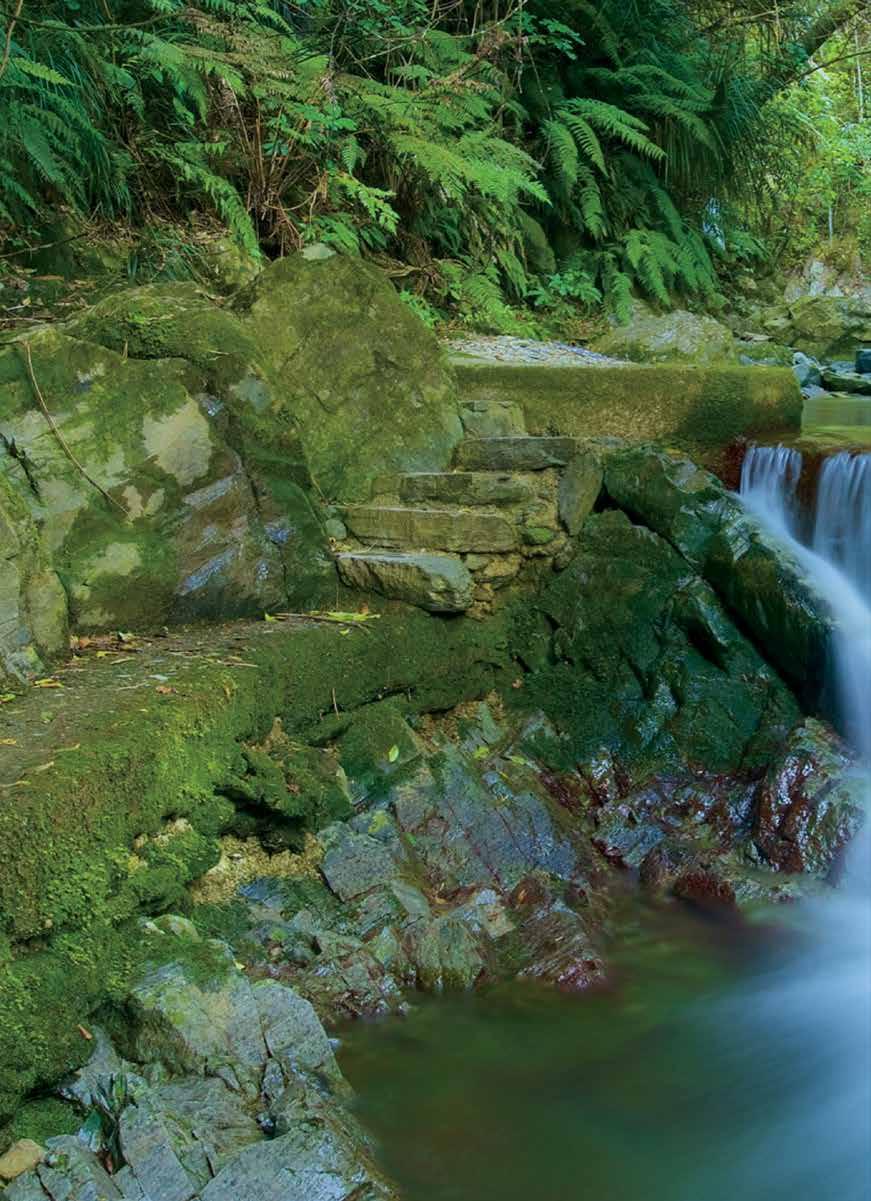
Enriching our community through connecting with nature Directory Patron Lou Sanson, QSM Board of Trustees Chris Hawkes Maurice Woodhouse Christine Hemi Debbie Armatage Paul Russell Deryk Mason Mike Elson-Brown Mike Glover Senior Management Richard (Ru) Collin - Chief Executive Nick Tilly (full time) - Office Manager Nick Robson (full time) - Operations Manager Contact The Brook Waimārama Sanctuary Admin office: (03) 546 2422 Visitor Centre at Sanctuary: (03) 539 4920 PO Box 744, Nelson 7040 info@brooksanctuary.org.nz www.brooksanctuary.org.nz Photo: Andrew MacDonald





















 Ru Collin Chief Executive
Ru Collin Chief Executive

































